Choosing Wix vs Webflow can be challenging, given their many similar features and diverse opinions. The best choice between Webflow or Wix depends on what kind of website you plan to create and what you value most: user-friendliness, design flexibility, additional features, cost-effectiveness, or something else.
To help you make a decision, let’s break down the differences between Webflow and Wix across several key areas. Hopefully, by the end of this comparison, you’ll have a clearer idea of which platform better fits your needs. Let’s get started.
Wix vs Webflow: Overview
Before comparing features, let’s start with a high-level overview of Wix and Webflow—their backgrounds, approaches, and user reviews.
What is Wix?
Wix has been around since 2006 and has carved a niche in website building. Millions of users from all corners of the globe trust Wix, and BuiltWith shows that it powers nearly 8 million sites worldwide.
They focus on making things easy, boasting a drag-and-drop editor and over 900 premade templates that skip the coding mumbo jumbo. They also offer an AI website builder, which lets anyone whip up professional-looking websites. Wix goes beyond the basics, offering a powerful editor (Editor X) and even marketing tools to help you get your site seen.
Community Reviews And Ratings
People appreciate Wix’s user-friendly interface, excellent customer support, and flexibility for creating and managing websites, making it a popular choice for beginners and small businesses.
Are you interested in learning more about Wix? Check out our comprehensive review for a deep dive into all the details!
What is Webflow?
Since its inception in 2013, Webflow has continuously developed its offerings, including the recent addition of eCommerce tools. This platform claims to equip expert web designers with the necessary tools to create professional, tailored websites. Webflow is designed for professionals with some design experience to craft highly personalized websites using a visual canvas.
It has recently become a go-to choice for many “no-code” web designers. According to data from BuiltWith, Webflow currently supports almost half a million websites globally.
Community Reviews And Ratings
People appreciate Webflow for its user-friendly interface, design flexibility, and scalability. It allows for easy integration of key features and handles technical aspects like responsiveness and SEO, all at a cost-effective price.
Curious about Webflow? Discover how it stacks up against WordPress by clicking here!
Wix vs Webflow: Features
Both Wix and Webflow offer a range of features to help build and design websites. Let’s dive into the key capabilities of each platform to see how they stack up in this Wix vs Webflow contest.
Wix Features
Wix provides many tools and features to simplify website building for users of all skill levels. This includes a drag-and-drop editor, templates, and eCommerce features that make Wix popular.
Templates
Wix offers over 900 professionally designed templates, with new ones added regularly and updates to current designs incorporating fresh elements and features. Most templates are designed to work well on computers and mobile devices like smartphones and tablets.
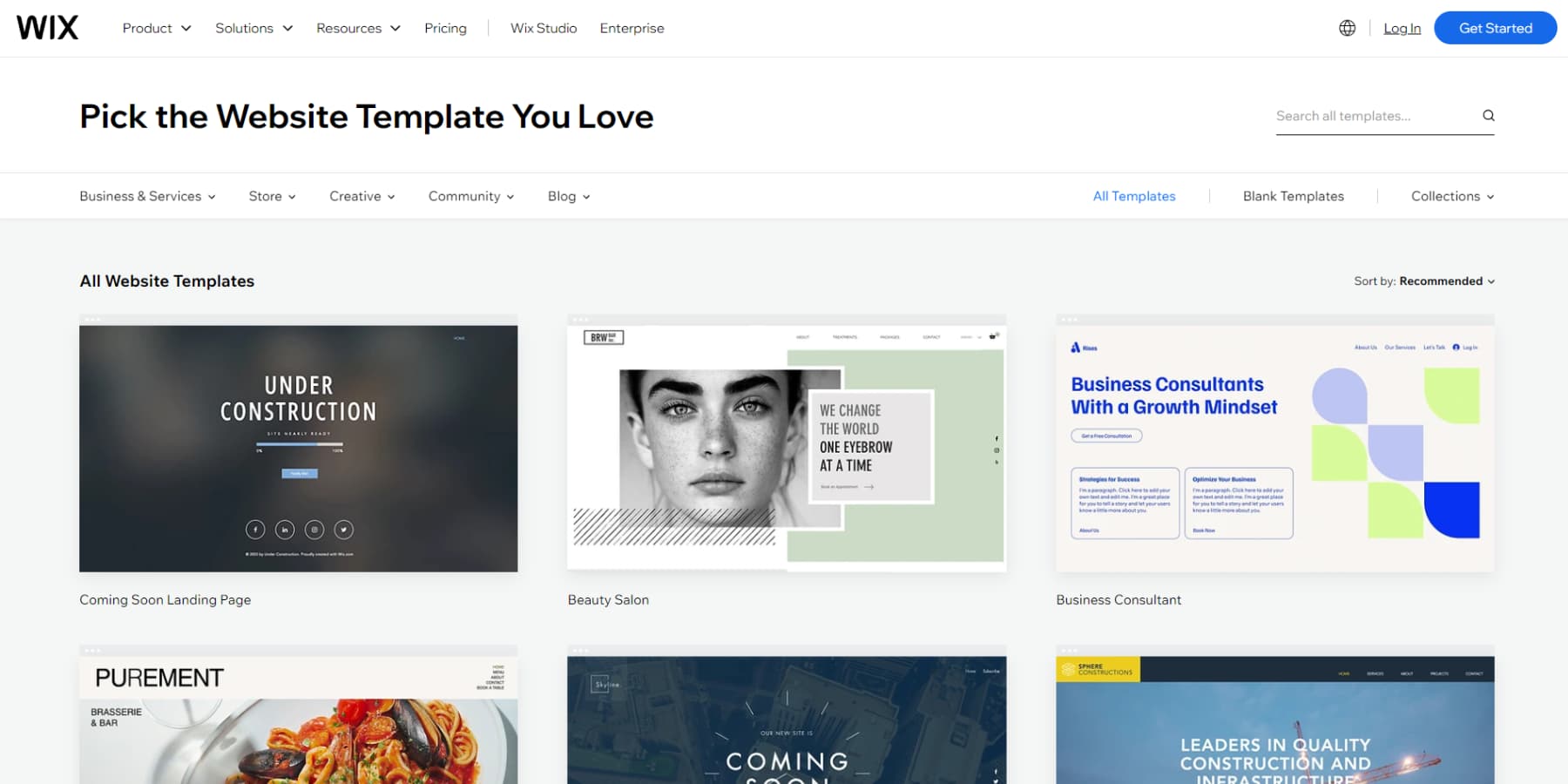
Your subscription includes access to all these templates at no extra cost. However, if none of the premade templates tickle your fancy, you can generate entire websites, copies, and images using Wix’s Artificial Design Intelligence (ADI). Answer a few questions, select your preferences, and bam! A website is designed for you. While the design may not be as polished as the premade templates, it is a surefire way to build your website and launch it quickly within days.
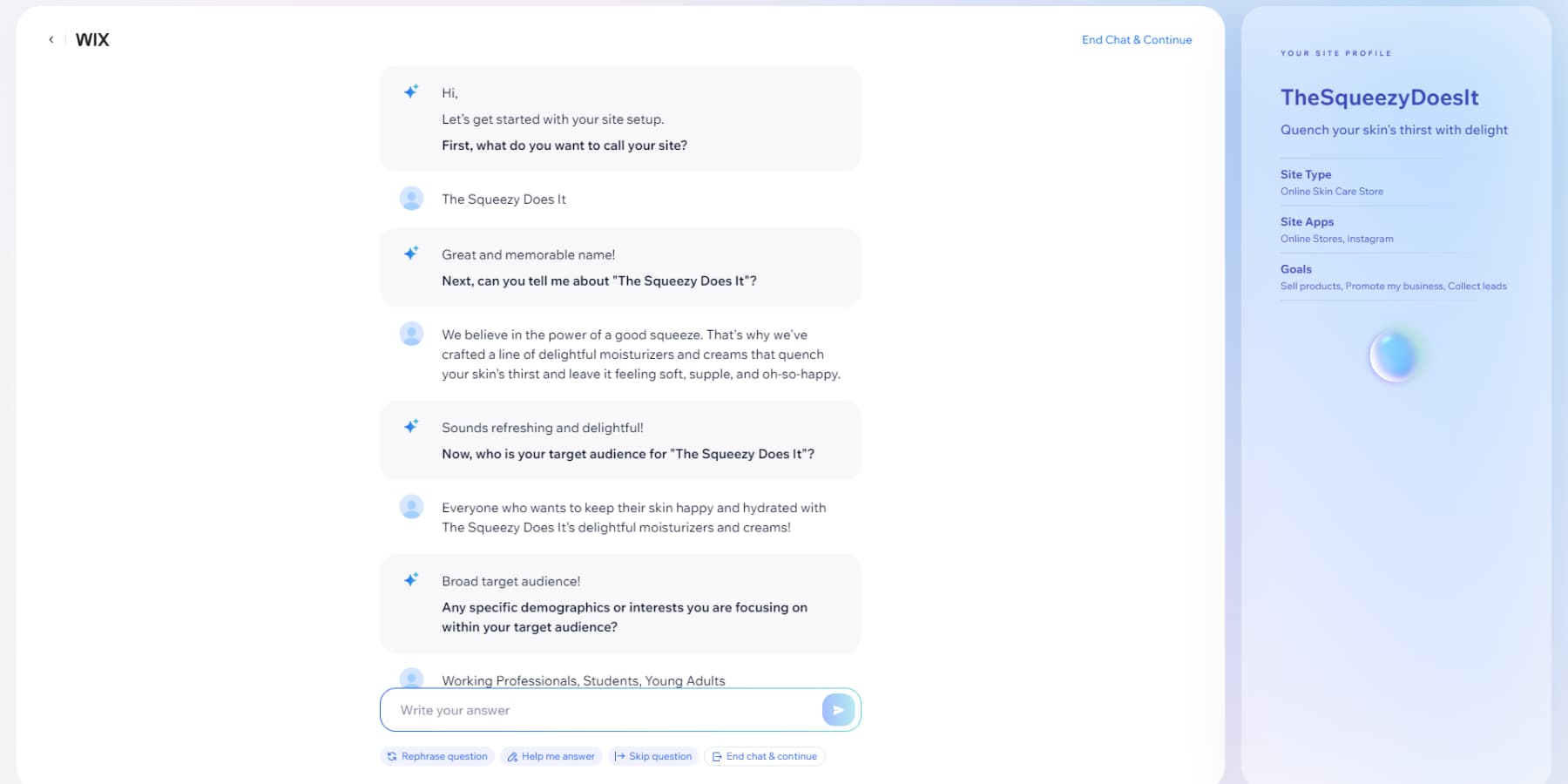
⚠️ Remember that switching to another template will cause you to lose your content once you select a theme. Choose carefully, or you’ll need to begin from scratch!
eCommerce Features
Choosing a Wix eCommerce plan (any plan above the light plan) allows you to quickly set up an online store on your website and start taking payments from customers. You can offer up to 50,000 physical, digital, and subscription products and link your site with well-known marketplaces and social media platforms.
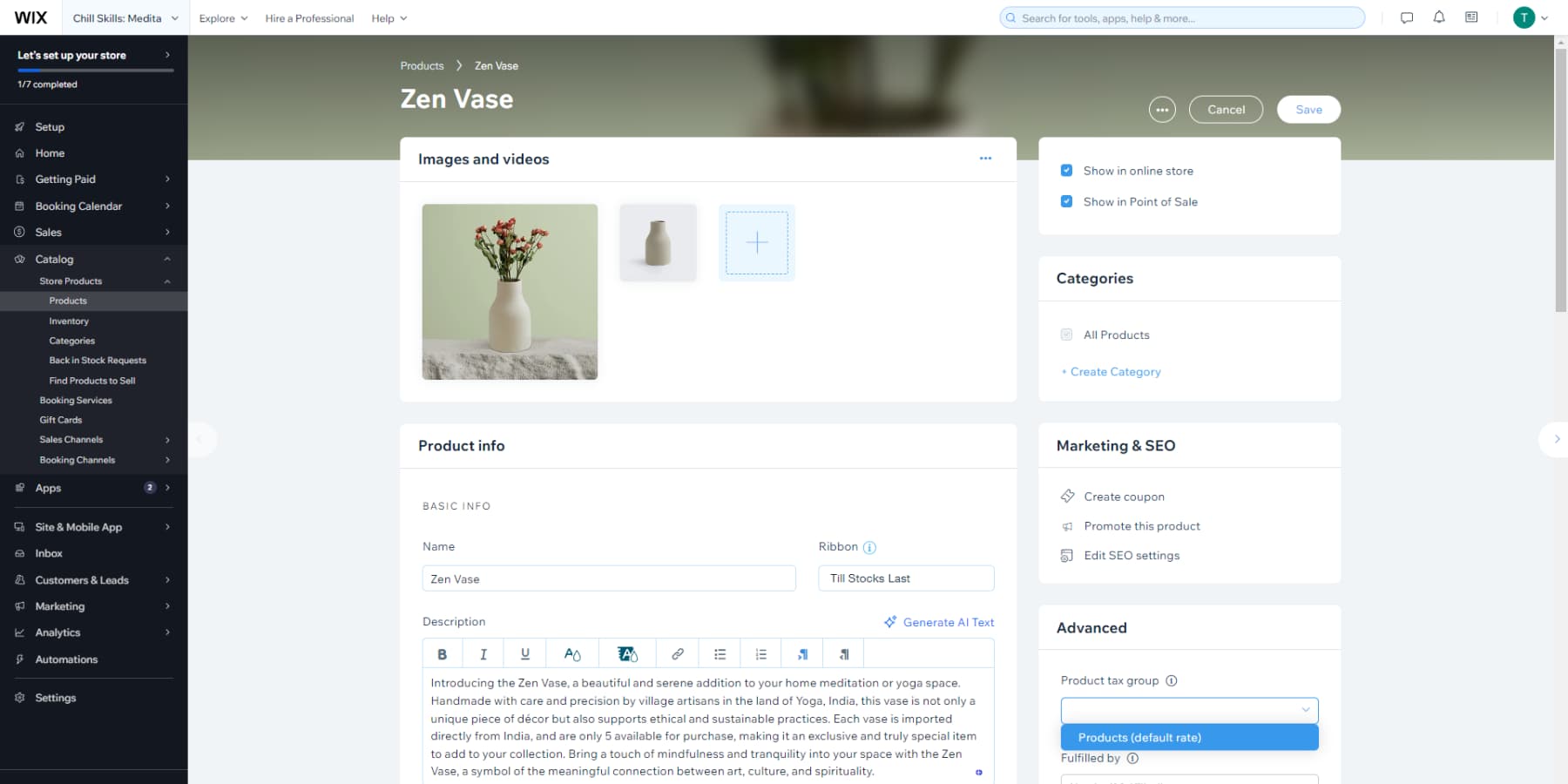
You can integrate Wix’s Point of Sale (POS) system with your website in the USA or Canada. However, be aware that Wix’s transaction fees might be a drawback for some, as they charge 2.9% plus 30 cents per transaction in the US when using Wix Payments.
There’s a wide selection of online store templates available for you. You can display product prices in various currencies and even in multiple languages on the Business and Business Elite plans. Wix offers robust shipping options. You can set up shipping rules based on a flat rate, the product’s weight, or its price. You can also automatically calculate sales tax, manage product reviews, and offer eGift cards if you’re subscribed to the Business or Business Elite plans. Not to mention, Wix has many advanced features that make it a great contender for online store creation, such as an abandoned cart recovery tool, plenty of payment options, loyalty programs, and more.
Wix provides excellent support through its Modalyst service for those interested in dropshipping. On the Core plan, you can list up to 25 products; on the Business plan, you can list up to 250 products. You can sell unlimited products if you’re on a Business Elite plan. Wix’s app market includes even more dropshipping apps, expanding your options further.
Other Key Features
Some other features of Wix consist:
- Plenty of integrations and feature add-ons via Wix Apps
- Built-in cookie consent tool
- Live chat, phone, and email support
- Unlimited form submissions
Webflow Features
Webflow has many features that help designers and developers create beautiful, responsive websites with customization options. Let’s explore some key features that make Webflow strong in web design.
Templates
Webflow offers over 2000 templates that make it easy to tailor your website. New templates are constantly being added. While some are available for free, others require a purchase, with prices ranging from $30 to over $100, depending on the design, complexity, and target customer of the template. They also offer an excellent template explorer. This handy tool enables you to search for themes based on their category, style, features, and type.
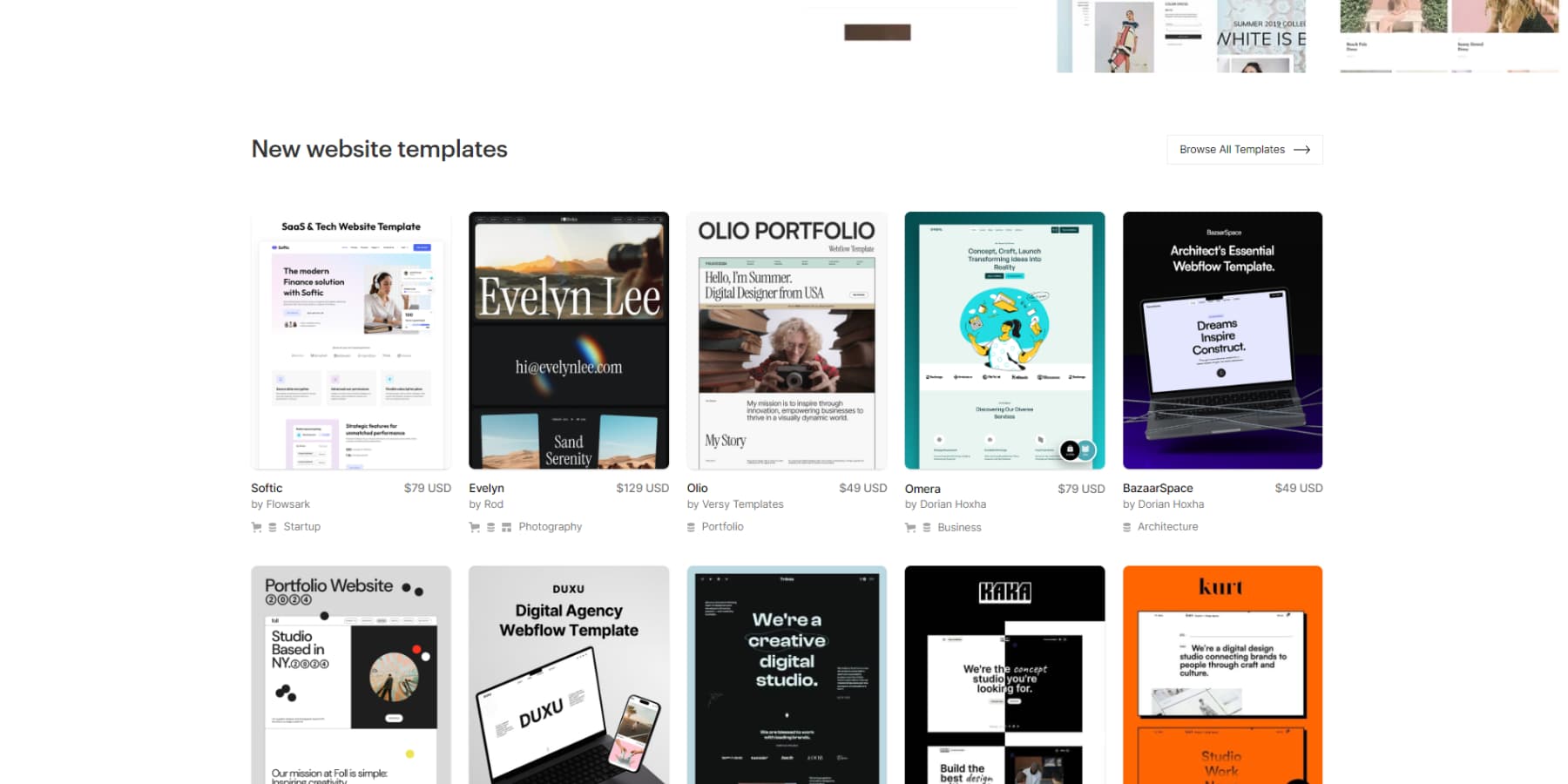
Additionally, you can download and install templates from third-party designers who bring their unique styles to the platform. Moreover, Webflow gives you access to all its web design tools, including dragging and dropping bare HTML elements. For instance, you can incorporate pre-designed components like sliders, tabs, and background videos, all customizable from the ground up.
You also have the flexibility to add empty layout elements such as containers, dividers, grids, columns, and sections into your design.
eCommerce Features
If you’re looking to showcase your products with a unique and customized approach, Webflow is a perfect choice. However, if you want to launch a full-blown online store, Webflow’s eCommerce capabilities are more basic than Wix, which started offering these services five years ago. Even the user interface for adding products looks pretty clunky, especially compared to Wix’s clean and organized interface.
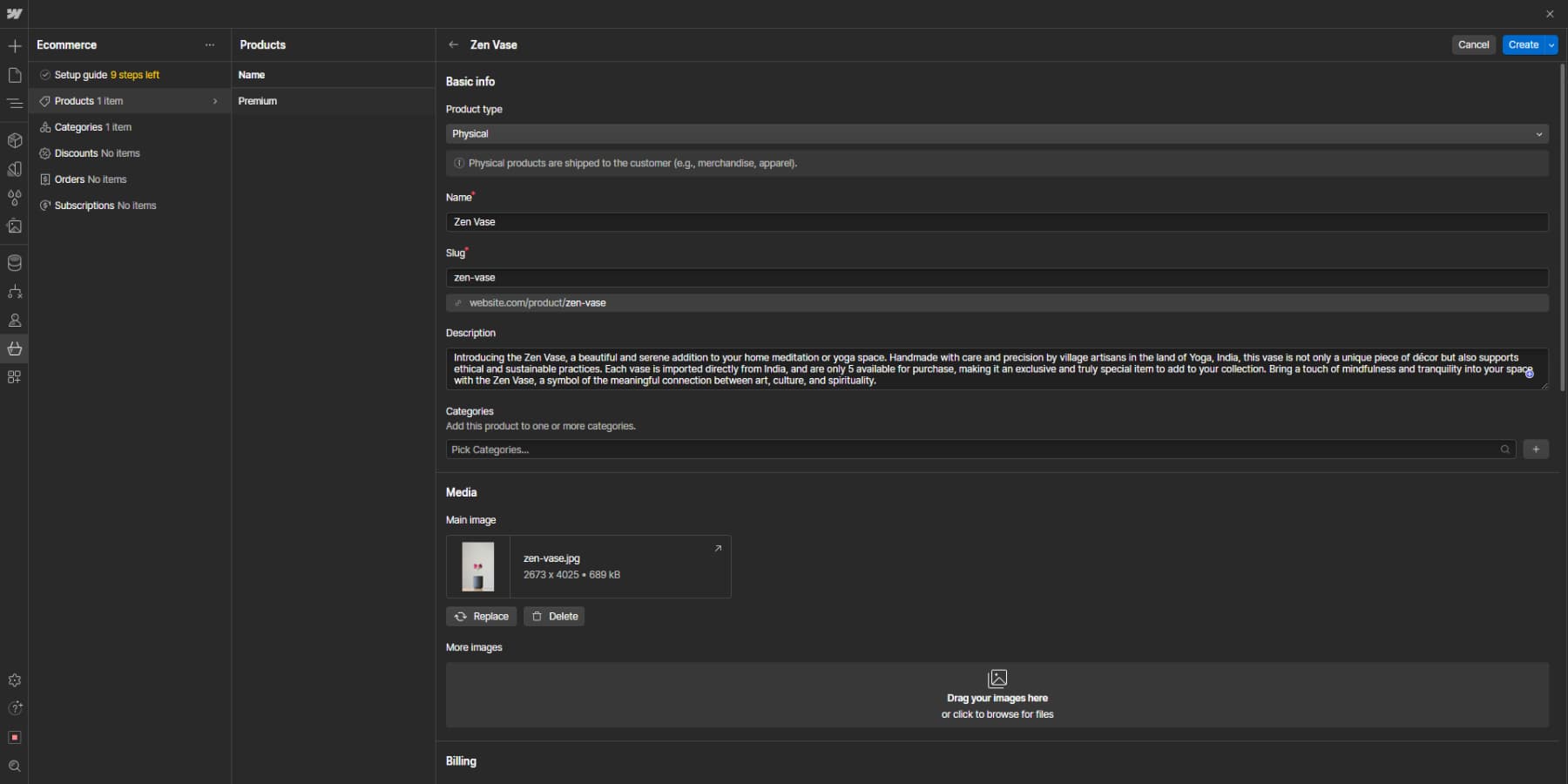
You can rely on this platform to handle fundamental eCommerce activities like selling physical and digital items, processing online payments, and managing shipping to your customers. However, you’ll find that many eCommerce functions in Webflow have rather frustrating restrictions.
For instance, with Webflow’s Advanced eCommerce plan, you’re capped at selling 15,000 products. This can feel quite restrictive, particularly when you compare it to Wix, where you can sell up to 50,000 products on any of their plans. Additionally, Webflow does not offer features like abandoned cart recovery, dropshipping, multicurrency support, or built-in POS integration. These restrictions can be solved by integrating third-party services via its App Store, which might add additional costs.
You do have access to a dashboard that allows you to view order details, monitor progress, and handle refunds. You can modify product fields, adjust your checkout and cart interface, tailor emails for transactions like receipts and order confirmations, and create unique landing pages.
Another downside of using Webflow for eCommerce is that you’ll be charged a 2% transaction fee on every sale and the fees from your payment processor if you’re on the basic eCommerce plan. Additionally, you can only set up three variations for each product, unlike in Wix, where you can add more.
Other Key Features
Other key features of Webflow include:
- Support for using third-party themes
- Better and bigger font options
- Workflow automation
- Webflow University to learn how to use Webflow
- Integrations with social media, MailChimp, and more
 |  |
|
|---|---|---|
| Features | 🏳️Draw Wix's features are more geared towards beginners, including AI tools and templates. | 🏳️Draw While Webflow doesn't have many features that Wix provides, it still offers unprecedented flexibility in terms of design. An extra point would also go for the availability of third-party templates. |
| Choose Wix | Choose Webflow |
Wix vs Webflow: Ease of Use
One of the most important factors when choosing a website builder is ease of use. Regarding Wix vs Webflow, both platforms are designed to be user-friendly but take slightly different approaches. Let’s examine how user-friendly Wix and Webflow are.
Using Wix
In this section, we will break down the ease of use and overall Wix experience.
Editor and User Interface
Like most modern web design tools, Wix uses a drag-and-drop feature that allows you to place elements anywhere on your site and craft your website just as you envision it visually. You can modify any part of a web page by clicking on it, bringing up Wix’s customization features. Each element is clearly labeled, making it easy to use without watching the tutorial videos. The editor’s sidebar is straightforward to navigate, enhancing user-friendliness.
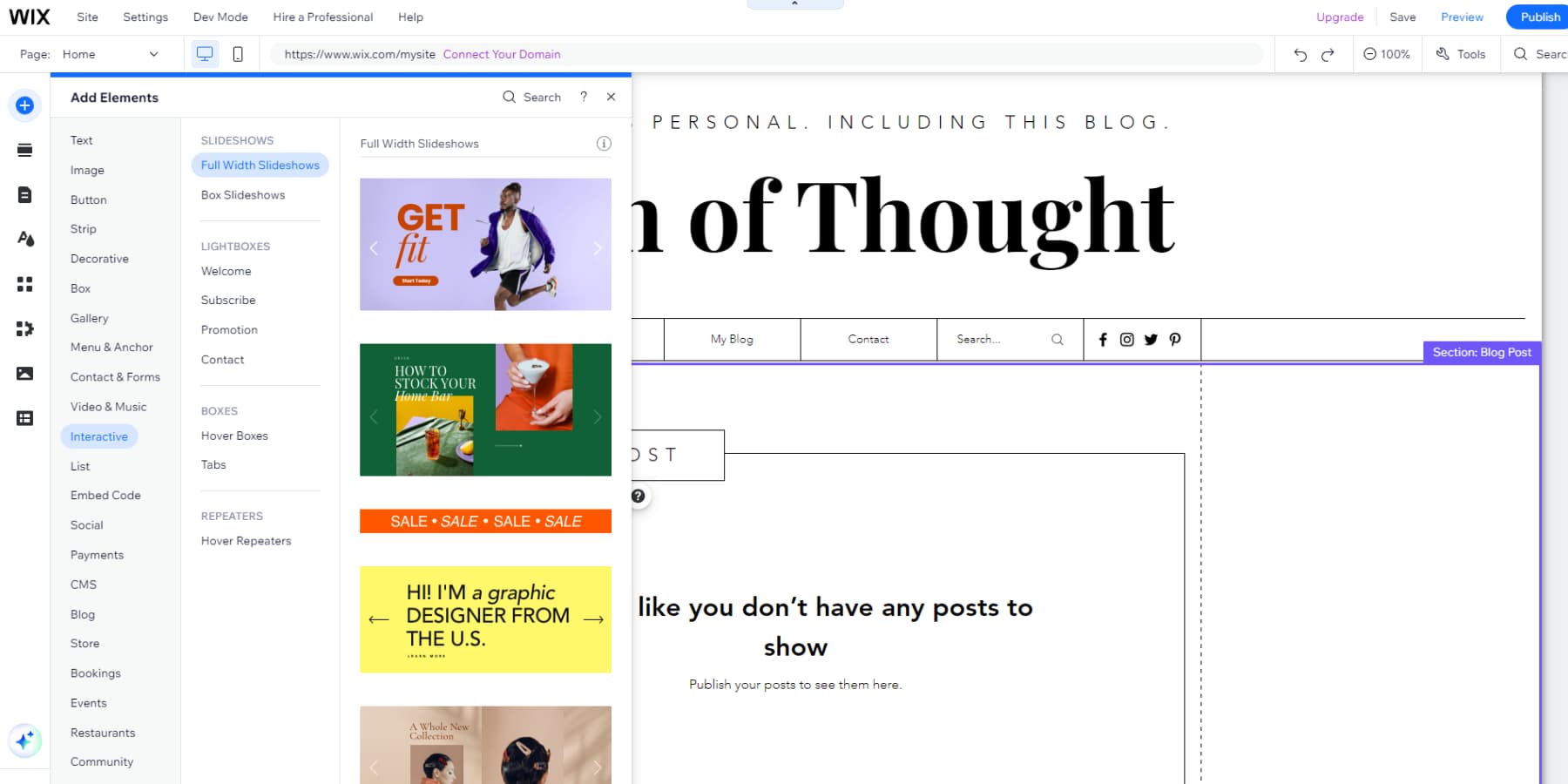
For most of its features, Wix includes a help button. For instance, if you want to change your text and aren’t sure how to proceed, click the help button. This action will direct you to the appropriate support documentation.
That said, this flexibility mainly applies to vertical placement. You have less control over the spacing between different elements on your web page. Also, it’s not straightforward to position items right into the corners of the page. Most Wix templates adhere to a strict responsive design that tends to center content, which is generally acceptable unless you aim to create a highly unique and complex web design.
Customization
Customizing your website with Wix is straightforward. Click on any component on the webpage to access various customization settings from Wix. You can change backgrounds in different sections and tweak individual elements on the page. For instance, you can adjust your text elements’ font size, color, highlight, link, and alignment.
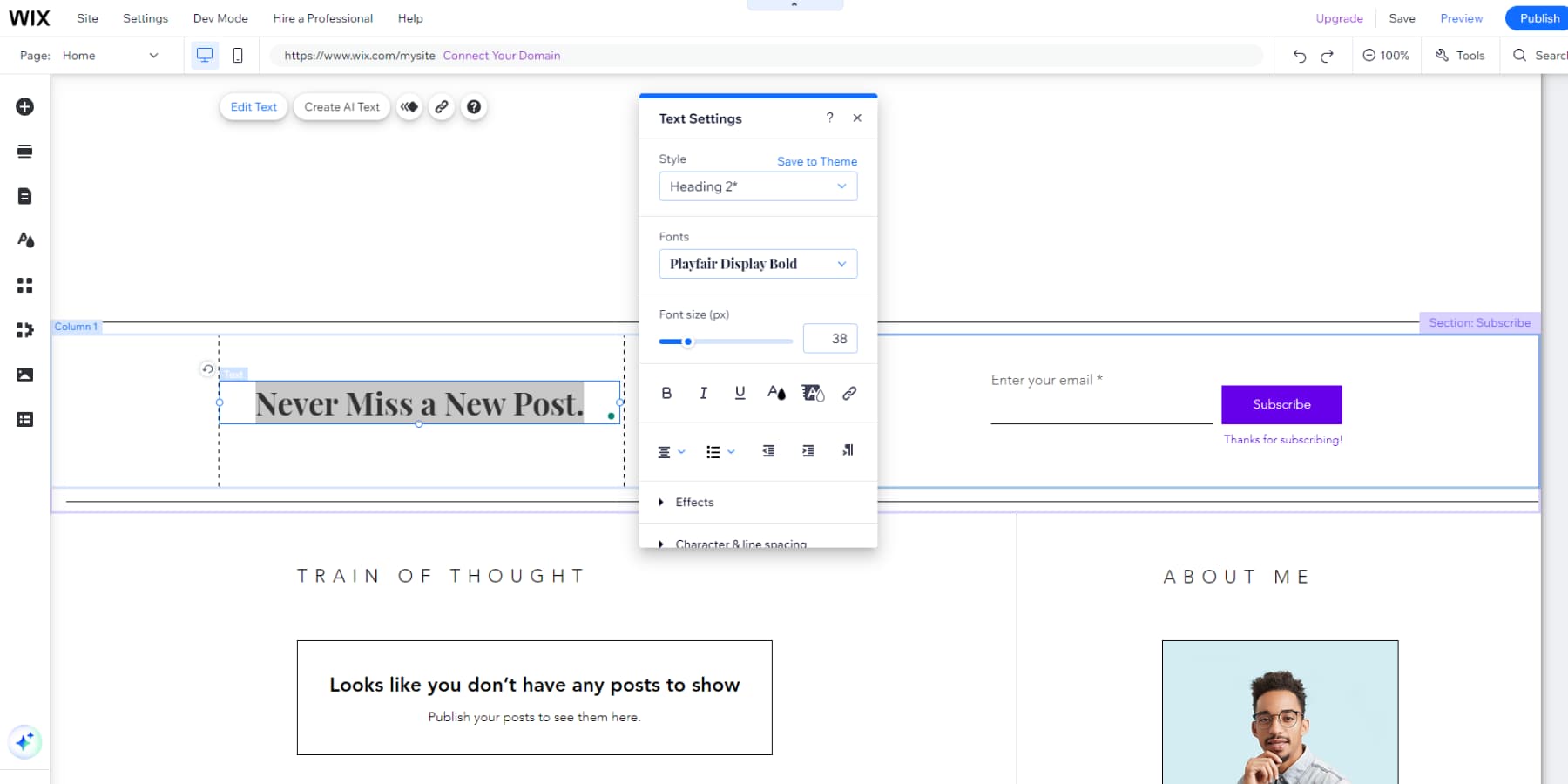
One major downside to otherwise easy customization is that you don’t have any control over margins and paddings whatsoever in Wix. At least not without coding. Although, you have the flexibility to place elements wherever you prefer. Conveniently, if your design might not display correctly on smaller screens, Wix notifies you with sound and text alerts.
Additionally, Wix offers about 15 animation types for elements on your pages, such as ‘bounce in,’ ‘expand in,’ and ‘slide in.’ You can easily set these animations through the Wix customization interface. Wix lets you incorporate various animations in your website backgrounds, including fade, freeze, and parallax effects. Generally speaking, while the animation features in Wix are pretty basic, they are sufficient if you want to incorporate some motion throughout your website pages. Not to mention its AI features. With Wix AI, you can easily generate a copy for your website in no time by answering a few questions.
The labels are clear and intuitive, making it easy to use even if you skip the video tutorials. Each feature typically includes a small help button that directs you to helpful documentation. These subtle cues make it very approachable to first-timers.
Overall Learning Curve
Wix offers beginners a reasonably straightforward learning curve, featuring a drag-and-drop interface and pre-designed templates, allowing quick website design and upkeep. However, as you delve deeper into customization and advanced features, the learning curve becomes steeper, requiring more time and effort to master the platform’s intricacies.
Using Webflow
In this section, we’ll delve into the user-friendliness and the comprehensive experience that Webflow offers.
Editor and User Interface
Webflow, like Wix, features a drag-and-drop interface. Although its editor may seem overwhelming with its many options, it becomes manageable with practice, similar to presentation software. Webflow uses a ‘box model’ for design, requiring elements placed in HTML boxes to organize and style pages. This offers excellent flexibility but has a steep learning curve, often involving technical jargon familiar to web professionals, which might confuse beginners. However, you may occasionally have to search for the meaning of the terms online.
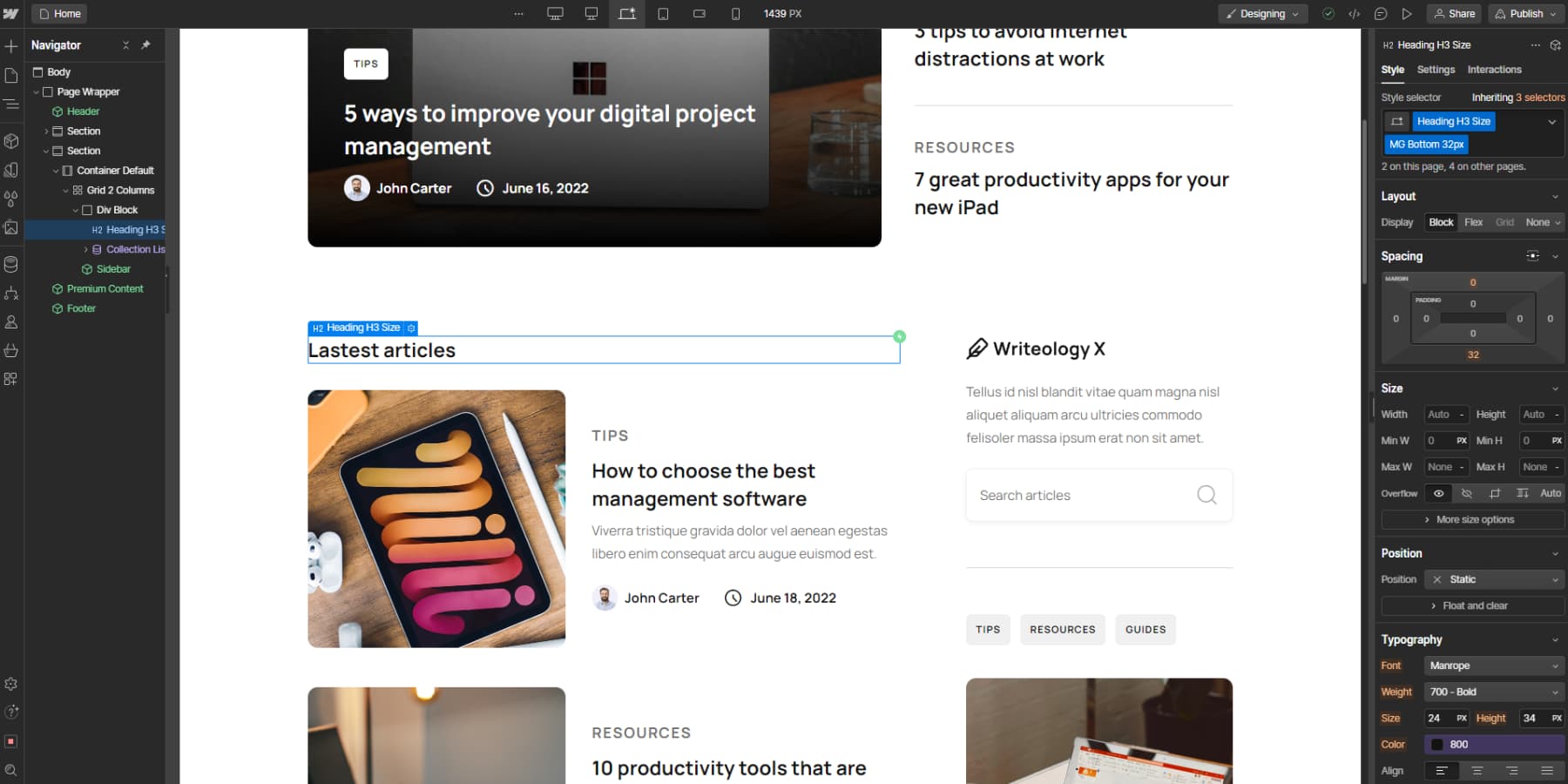
To give Webflow its due, if you plan to update the text on a pre-designed template, you can pick up this skill in a few hours. However, if you aim to build new sections or design animations for your website from the ground up, realistically, it will take most of you a few months to master these tasks.
Customization
While Webflow stands out in terms of customization, the platform offers many features that seem daunting to new users. You can even see the CSS code for each element you edit; typically, Webflow provides more customization options per element than Wix does. Unlike Wix, Webflow allows you to tweak the padding and margins of web pages.
The animation tools in Webflow are robust and represent a significant advantage of using the platform. Like Wix, you can access preset animations such as ‘fade,’ ‘shrink,’ ‘pulse,’ and ‘bounce,’ which can be added to any design element. Moreover, with Webflow’s ‘interactions’ tool, you can create your animations. This tool offers sophisticated features for crafting animations and setting up ‘triggers’ that activate based on user interactions.
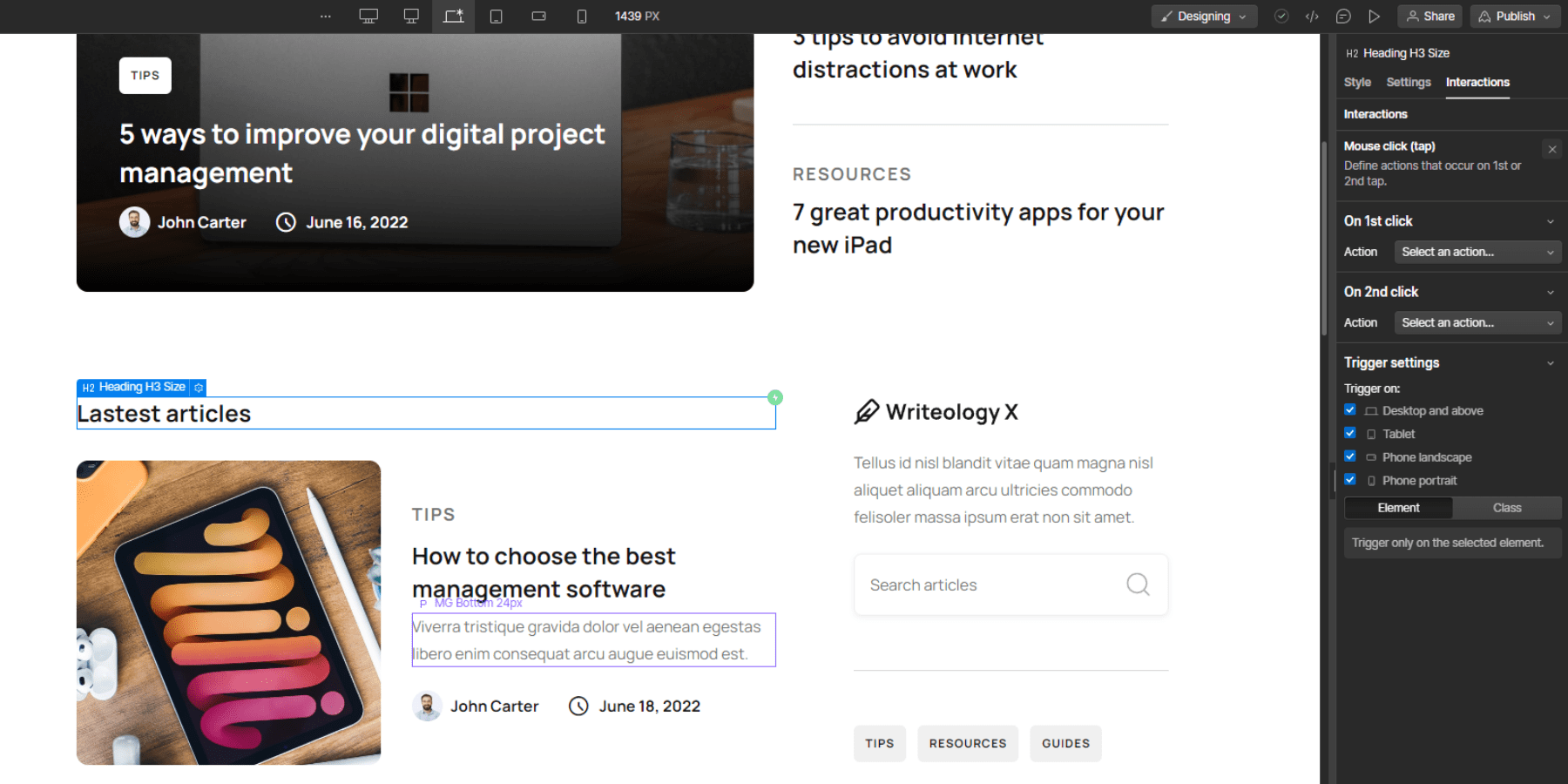
If you’re already skilled in web design, you’ll likely find that Webflow’s offerings align well with traditional web development practices, making it a bit challenging for complete beginners, especially when compared to Wix.
Overall Learning Curve
Webflow has a much steeper learning curve than Wix due to its advanced design and customization capabilities. Although Webflow’s visual canvas interface is somewhat intuitive, mastering its features and CSS-like styling requires more time. However, once you become proficient, Webflow offers greater flexibility and control over website design than the more beginner-friendly Wix platform.
 |  |
|
|---|---|---|
| Ease of Use | 🥇 Winner Wix's user interface, hands down, is much easier to use. However, this ease of use sometimes means compromising on some flexibility. This might not be an issue for beginners or intermediate users. | Webflow's user interface and learning curve are steep, so much so that even experienced users sometimes find it hard to use. However, with this complexity comes total control over all design aspects of the website. |
| Choose Wix | Choose Webflow |
SEO and Marketing Tools
Search engine optimization and marketing are crucial for driving traffic to your website. When comparing Wix vs Webflow, it’s important to explore their SEO and marketing capabilities to see which platform gives you an edge in getting found online and promoting your business effectively.
SEO and Marketing In Wix
Wix provides a range of built-in SEO and marketing tools to help optimize and promote your website. Let’s go over some of them.
Features
Wix provides a built-in SEO tool, also known as the SEO wizard, right on your dashboard. This feature guides you through the necessary actions to enhance your website’s SEO. You can even connect SEO tools, such as SEMRush and SE Ranking, to get keyword suggestions for your website.
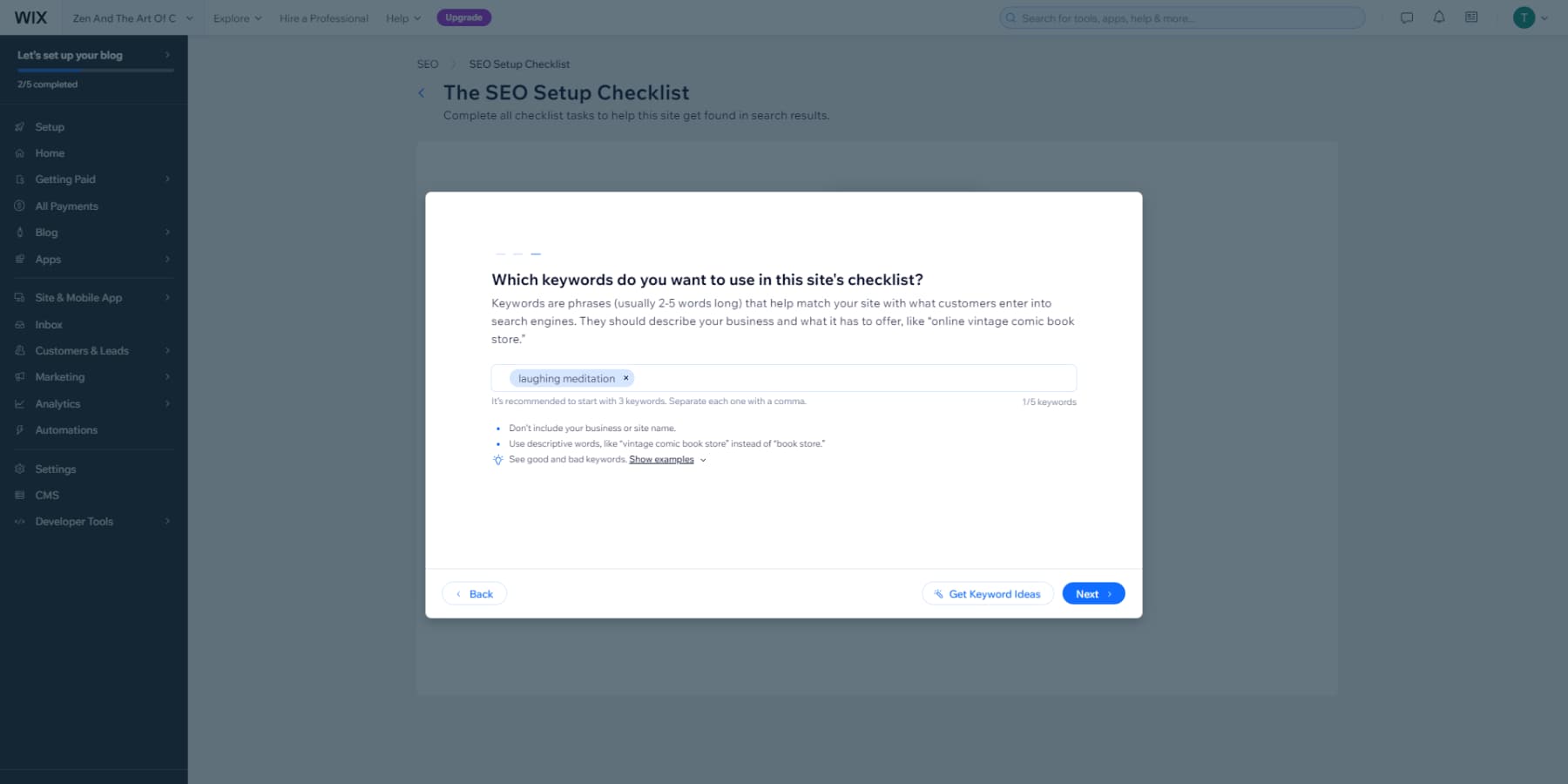
Additionally, you can modify page descriptions and meta titles, add image descriptions, and set up 301 redirects. Wix sites are also optimized for mobile use, a plus for SEO. But there’s a small catch. Wix sites aren’t genuinely responsive; they are mobile-friendly but not responsive in the strictest sense. This means Wix creates separate versions for desktop and mobile rather than a single, adaptable site. Generally, this isn’t a problem, but sometimes Google might prefer to index one fully responsive website over two separate versions.
Additionally, integrating with Google Analytics can provide deeper SEO insights and help identify improvement opportunities. You can conveniently submit your site’s sitemap using the SEO wizard, which requires linking to Google Search Console (GSC). If you prefer not to share your GSC details with Wix, you can manually submit sitemaps, although this method is more complex and time-intensive. In our tests, Wix showcased impressive loading times. It typically loads in under 1.5 seconds, although these speeds vary from website to website.
With its versatile email designer, Wix offers a significant advantage, which is ideal for crafting various emails, including newsletters, not just transactional messages. You can send up to 200 emails monthly for free across all Wix plans. If you need to send more, Wix provides premium email marketing packages starting at about $10 monthly for 500 emails.
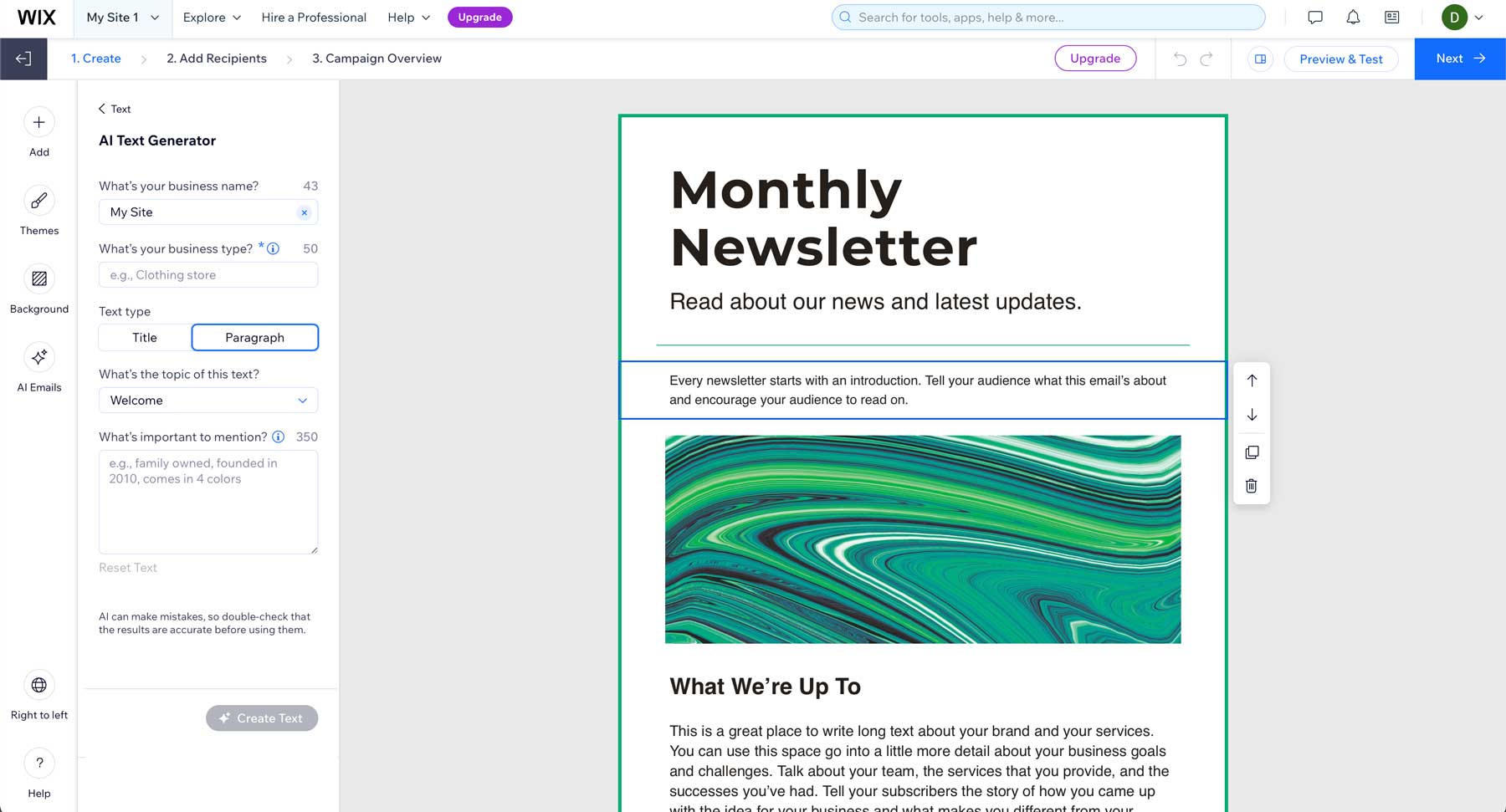
The user-friendly email designer uses premade templates and a drag-and-drop system similar to Wix’s website builder. This makes it easy to design emails, even though they differ from website design.
Blogging Tools
To set up your blog’s layout, you can choose from several blog-specific templates separate from your main website template. These simple templates focus solely on the arrangement of your blog. In your Wix dashboard, you can manage your blog by adding a featured image and a post header, using headings, incorporating pictures and multimedia, and organizing your posts with tags.
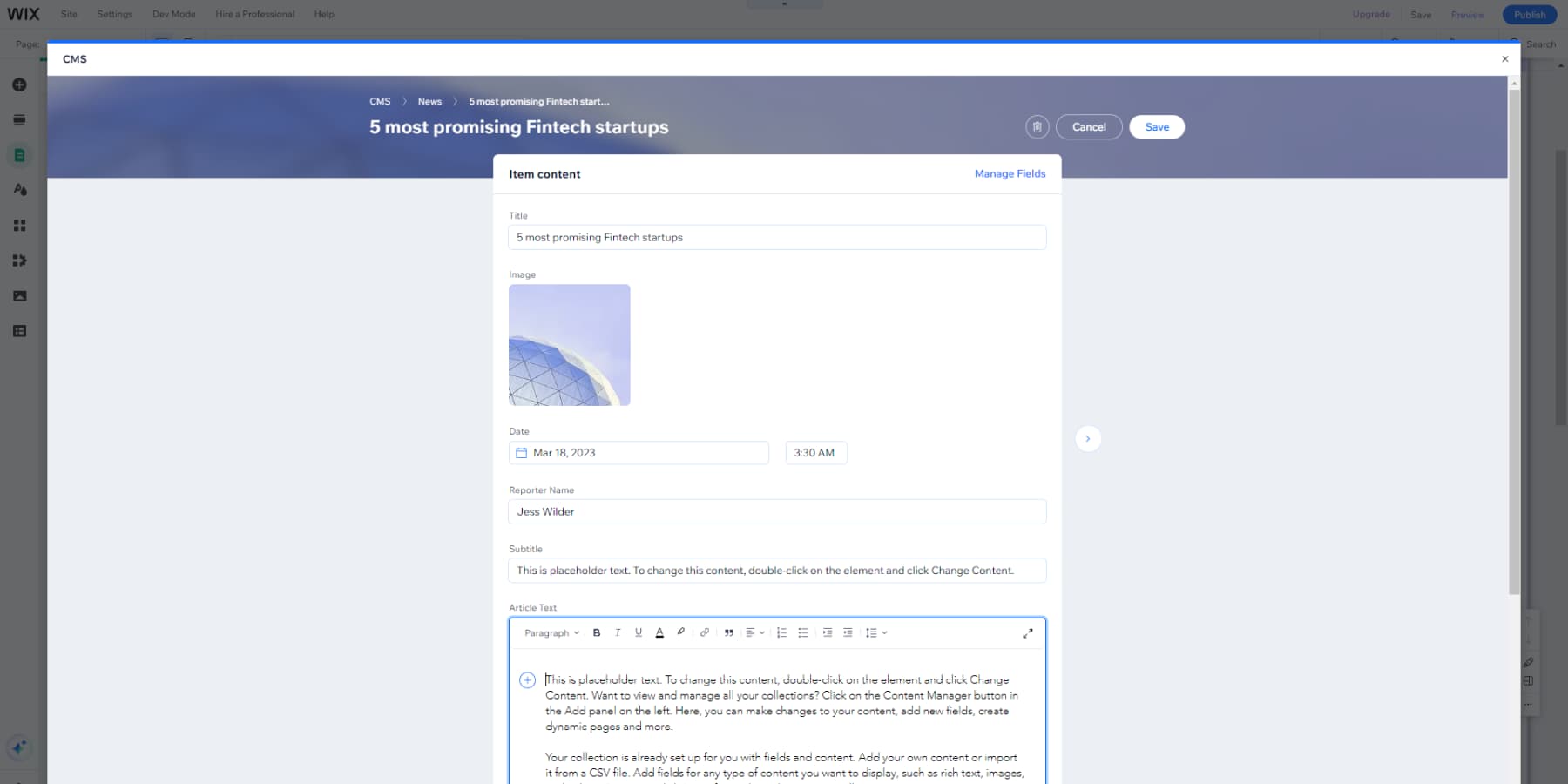
However, you might find Wix’s Content Management System (CMS) slower and more cumbersome than other platforms like WordPress. Wix does offer the option to import blog posts from another Wix site or WordPress.
There are some restrictions, though. For example, you cannot make posts private or backdate them. The primary text editor has limited formatting capabilities, which can be a constraint if you want to design your blog extensively. But, if your needs are straightforward — including text, images, and videos with attractive headings — this platform should work well for you.
SEO and Marketing In Webflow
Webflow equips users with powerful SEO and marketing capabilities to boost online visibility. Take a look.
Features
Although Webflow lacks a dedicated SEO Wizard like Wix, its features allow you to accomplish nearly all the same SEO tasks. URL slugs, meta titles, meta descriptions, and image alt text? Check, check, and check. Webflow offers you more detailed control over your SEO settings. It allows you to establish indexing rules, SEO markup, redirects, and additional features.
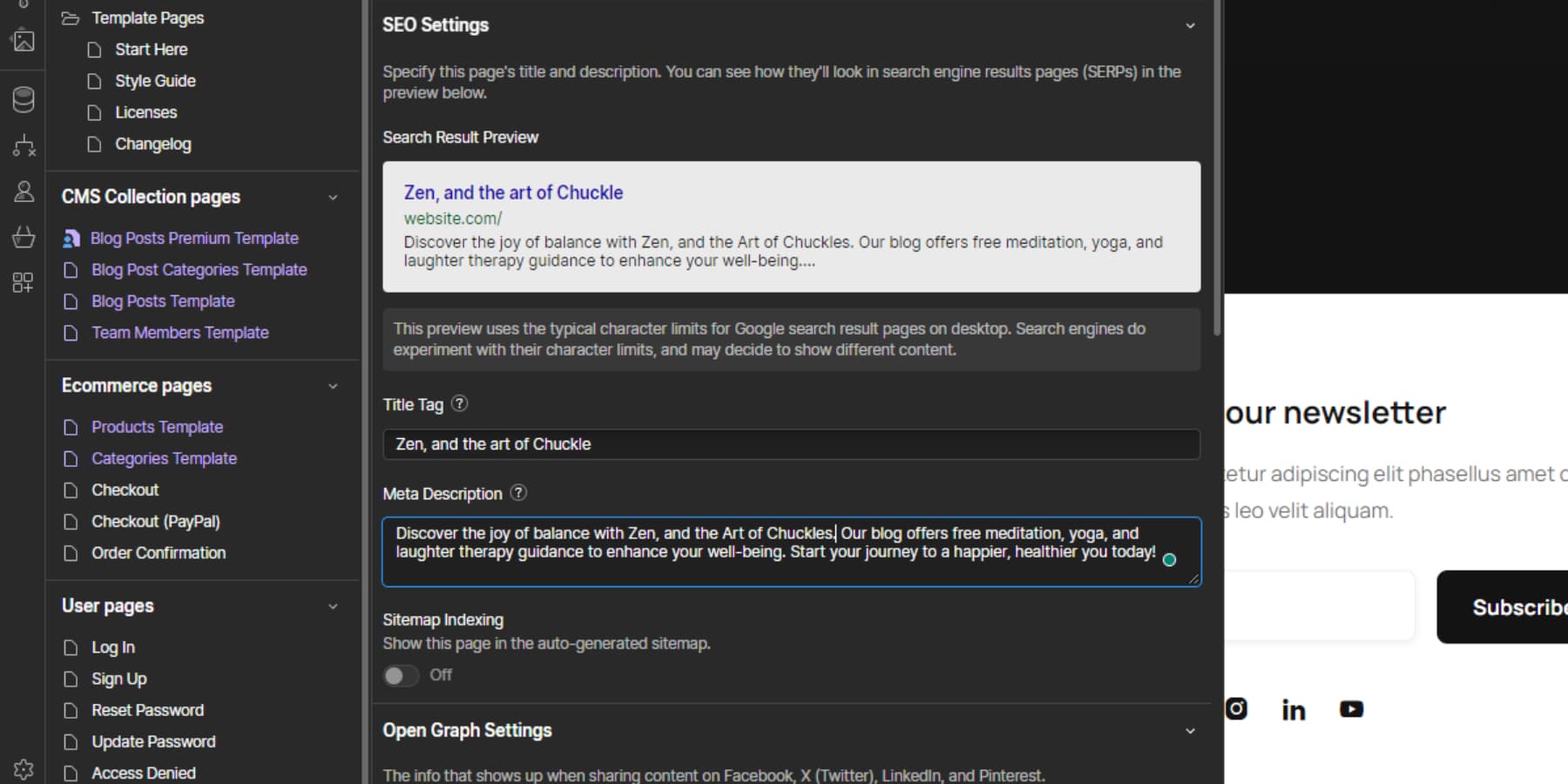
Additionally, it simplifies automatically updating and creating a sitemap each time you publish your project. You can also integrate a variety of SEO tools from Webflow Apps. According to our tests, Webflow offers neatly organized code and slightly quicker loading times than Wix. It also supports genuine responsive design, a plus for SEO. However, Webflow doesn’t simplify SEO optimization as much as Wix does; consider how important it is for you to have full control over your website’s SEO and visibility.
When discussing emails in Webflow, it’s important to note that, unlike Wix, Webflow doesn’t offer a comprehensive email marketing platform. However, you can personalize the emails sent out when someone submits a form on your website. The downside is that Webflow limits how many form submissions you can receive monthly — ranging from 500 to 2,500, depending on your subscription plan. If you exceed this limit, you must pay an additional fee.
Blogging Tools
Now, to sound like a broken record: Webflow offers impressive control, but starting a blog with Webflow isn’t as straightforward as with Wix. While you can begin a Wix blog without any previous experience, you’ll likely find it helpful to familiarize yourself with the CMS before diving into adding posts, as it seems disorganized and migraine-inducing if you haven’t worked with similar tools in the past.
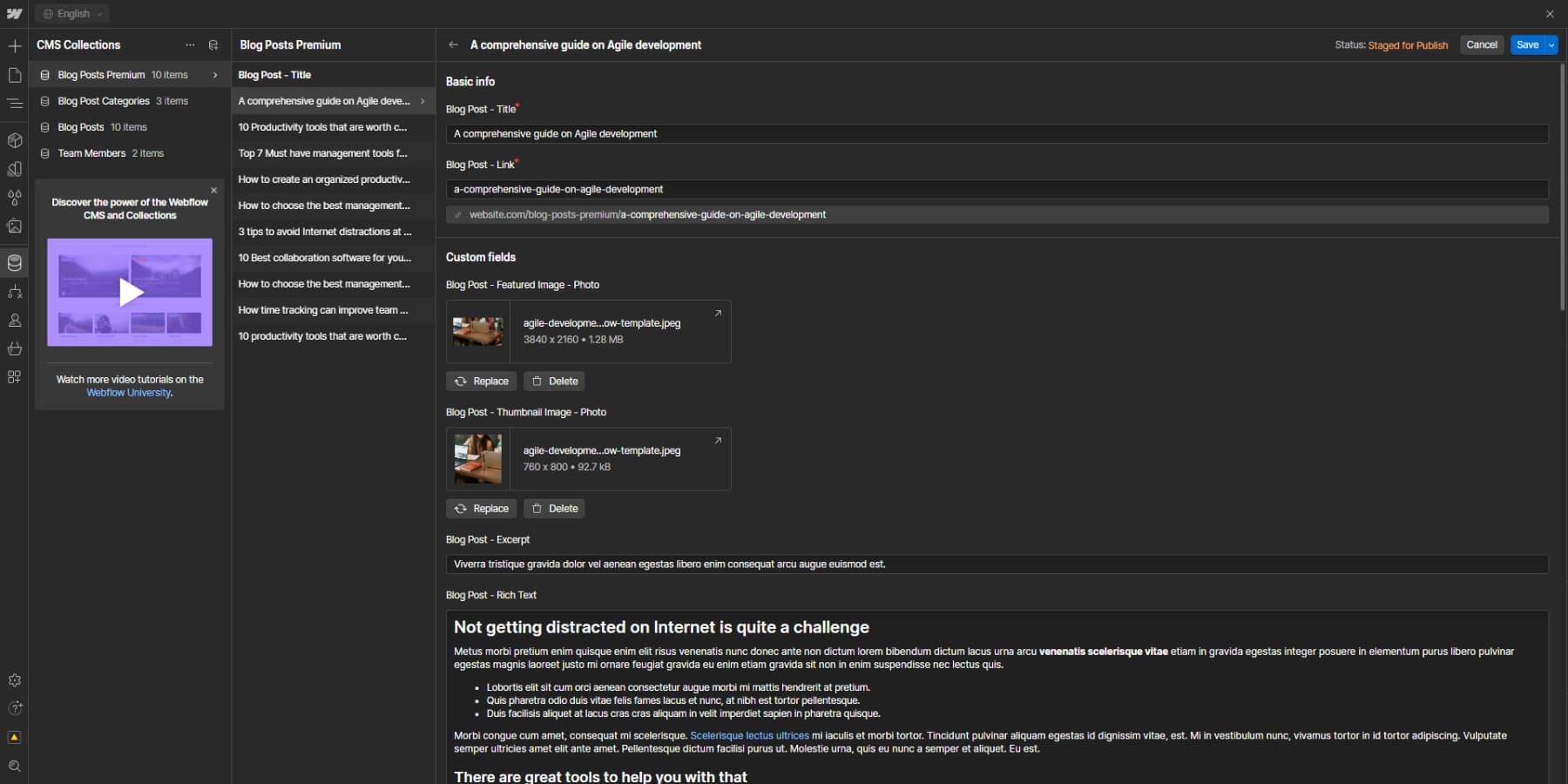
Editing your blog posts can be tricky. You need to fetch them from your CMS collections, and if you want to change their style, you’ll have to introduce a rich text field and tweak the classes for headers and text accordingly. However, even its most expensive plan lets you add only 10,000 CMS items, i.e., blog posts and other dynamic parts. Extremely restrictive!
Fortunately, Webflow automatically creates meta titles, descriptions, and open graph settings to simplify the process, which can get quite complex. These settings are crucial because they dictate what information appears when your content is shared on social media. Don’t worry, though; you always have the option to alter these auto-generated elements manually.
 |  |
|
|---|---|---|
| Marketing and SEO | 🥇 Winner Wix makes marketing easier for you by letting you update what appears in Google searches through its easy-to-use SEO wizard and integrations, and also by enabling customized emails. Its blogging features while limited is still very simple to use. | Webflow, while providing the same SEO features, lacks an automatic wizard and integrations, which may require manual work. The email features are limited to just transactional emails. The Webflow CMS is very flexible but complex and unintuitive with severe limitations. |
| Choose Wix | Choose Webflow |
Wix vs Webflow: Pricing
Cost is often a deciding factor when choosing a website builder. In this section, we’ll break down the pricing plans and overall value propositions of Wix and Webflow.
Wix Pricing
Wix doesn’t list what is provided in its free plan. however, you can sign up and test things out for yourself. The only limitations we encountered were using the domain, removing the branding, and adding products. So, let’s take a look at Wix’s paid plans.
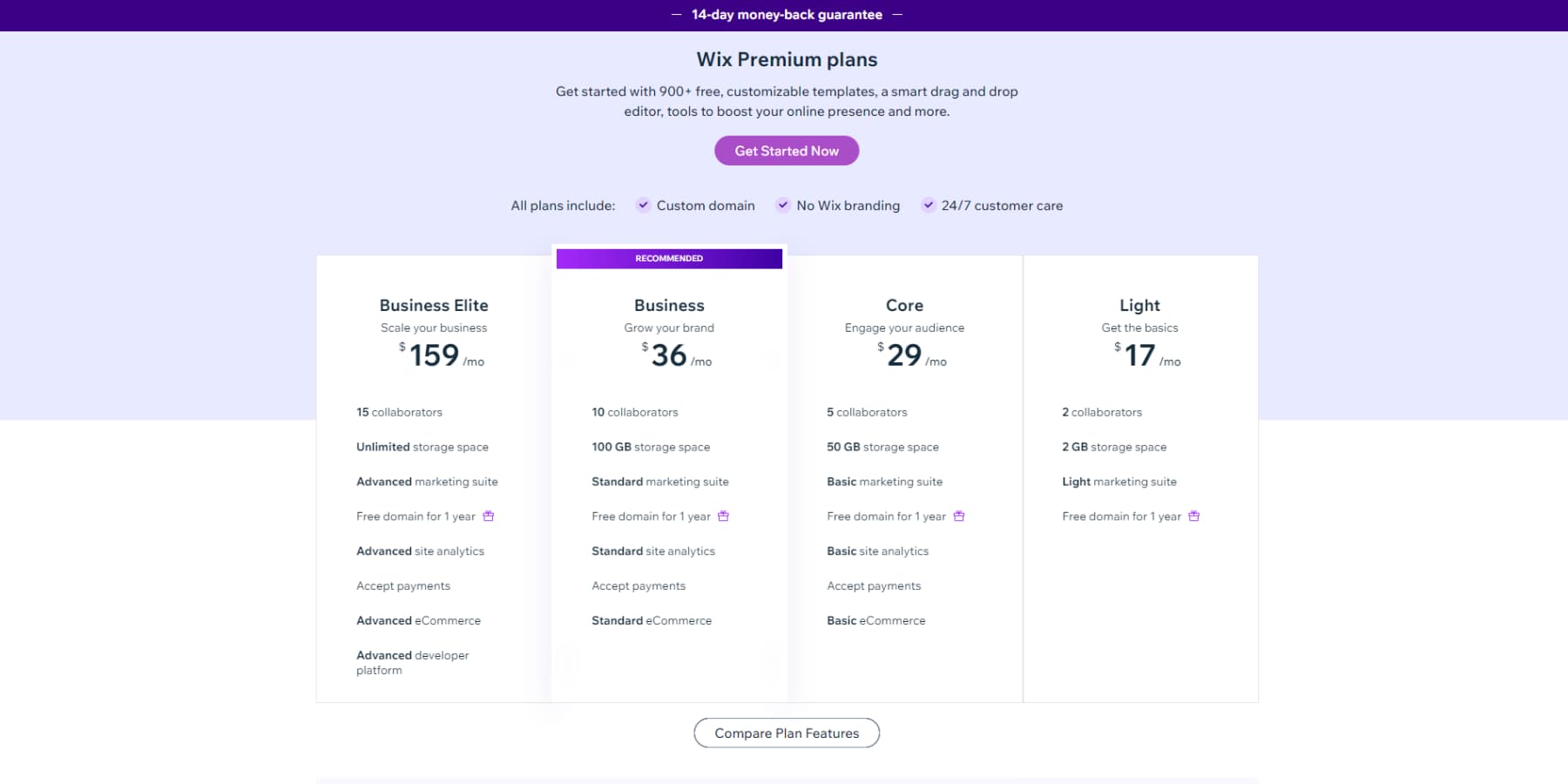
Light
Starting at $17/month, this plan offers the ability to add a custom domain and even includes a free domain for the first year. Additionally, you can remove Wix branding. However, storage space is restricted to just 2GB. Also, this plan does not support eCommerce features. Marketing tools are also limited; for example, there is no live chat widget, and only 10 form fields are available per form. The Light plan is excellent for anyone looking to quickly launch a website without any advanced features.
Core
The core plan, which starts at $29/month, includes all the features of the light plan without the limitations. With this plan, you can have up to 50GB of storage, customer accounts, an events calendar, a site booster app (free for a year), 50 form fields per form, a site chat widget, and all basic eCommerce features such as selling up to 50K products, abandoned cart recovery, and discount management, among others. This is a perfect plan for launching an online store on a strict budget.
Business
The Business Plan includes all the features of the Core Plan but with higher limits, such as 100GB of storage and 75 fields per form, starting at $36/month. It also supports automated sales tax calculations, 1,000 product reviews, advanced branded gift card options, advanced shipping tools, and support for selling in up to six currencies. This can be a great upgrade if your store is growing.
Business Elite
The Business Elite plan, starting at $159/month, is targeted towards large online stores that have outgrown the Business plan. It includes all Business plan features, unlimited storage space, priority customer care, 100 fields per form, automated sales tax calculation for up to 500 transactions, loyalty program support, 3,000 product reviews, and support for selling in up to 10 additional currencies.
Webflow Pricing
Let’s explore the pricing structure of Webflow. There are two types of Webflow pricing plans: General and eCommerce. Let’s start by exploring the General pricing:
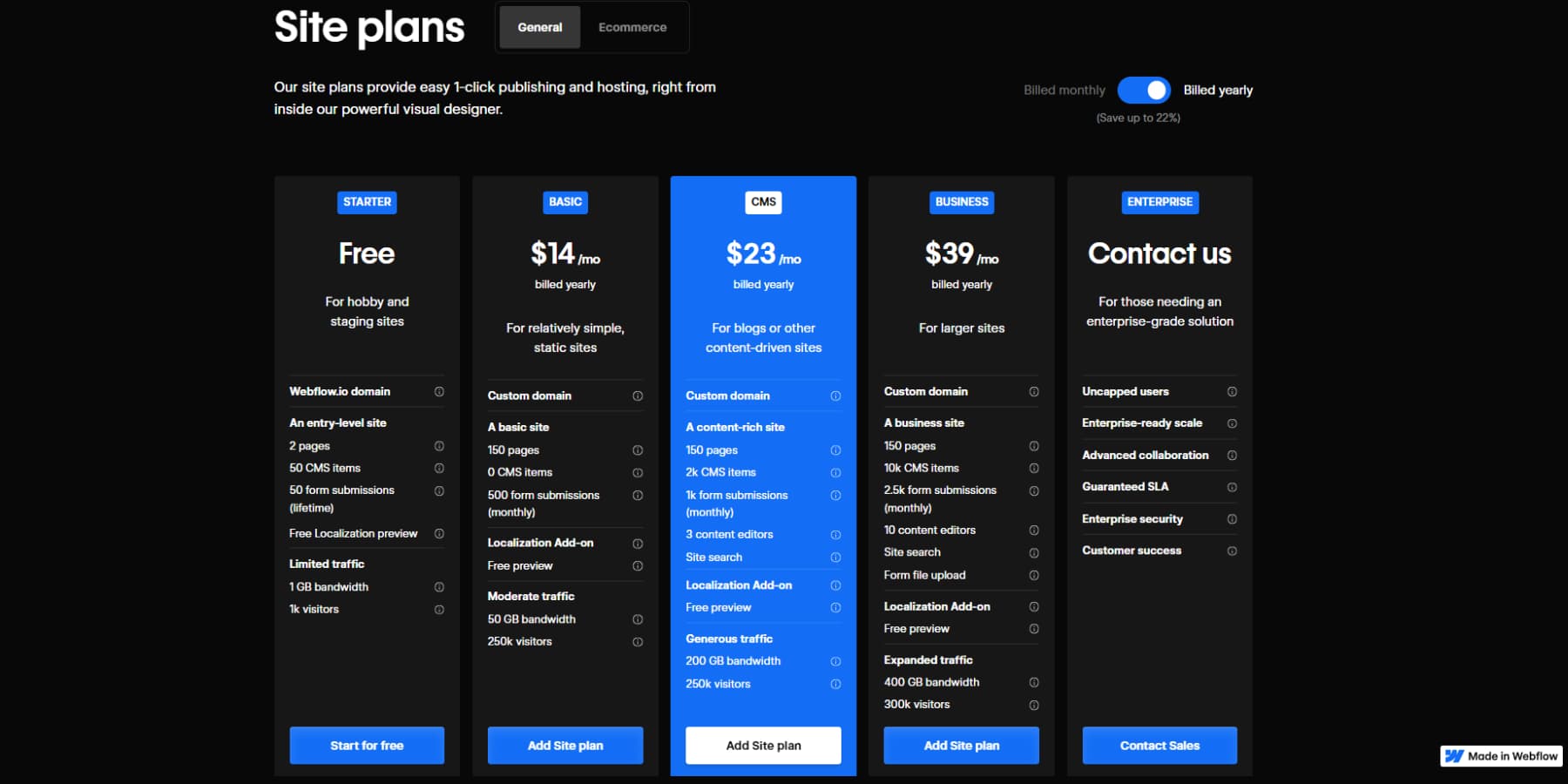
Free
As the name suggests, the free plan from Webflow allows you to use their services at no cost indefinitely. This option will enable you to create up to 2 pages and manage 50 CMS items like blog entries and similar items. You also get a limited 50 form submissions as part of this deal. However, this plan limits you to 1 GB of bandwidth and roughly 1,000 visitors, and you won’t be able to use your custom domain or SEO features. This plan is ideal if you want to explore what Webflow offers without investing in a paid subscription.
Basic
Starting at $14 per month, the basic plan provides up to 150 pages, 500 monthly form submissions, 50 GB of bandwidth, and approximately 250K unique visitors per month. However, a significant drawback of this plan is the lack of any CMS support. Nevertheless, it allows publishing to a custom domain and access to all SEO features. This would be an excellent option for anyone creating a basic website with Webflow without needing advanced features.
CMS
The CMS plan starts at $23/month and includes all the features of the Basic plan. Additionally, you can have up to 2,000 CMS items and up to 1,000 form submissions per month. You can add up to three editors (team members) to assist you and enable site search on your website. This plan provides 200 GB of bandwidth, though visitor numbers are capped at 250,000 per month.
Business
The business plan starts at $39/month. This includes everything from the CMS plan, an upper limit of 10,000 CMS items, 2,500 form submissions, ten content editors, 400 GB of bandwidth, and 300,000 monthly unique visitors. Unlike other plans, this allows visitors to submit files through the forms.
Apart from these plans, if you wish to add eCommerce to your website, you must purchase one of its eCommerce. Let’s take a quick look at its eCommerce plans:
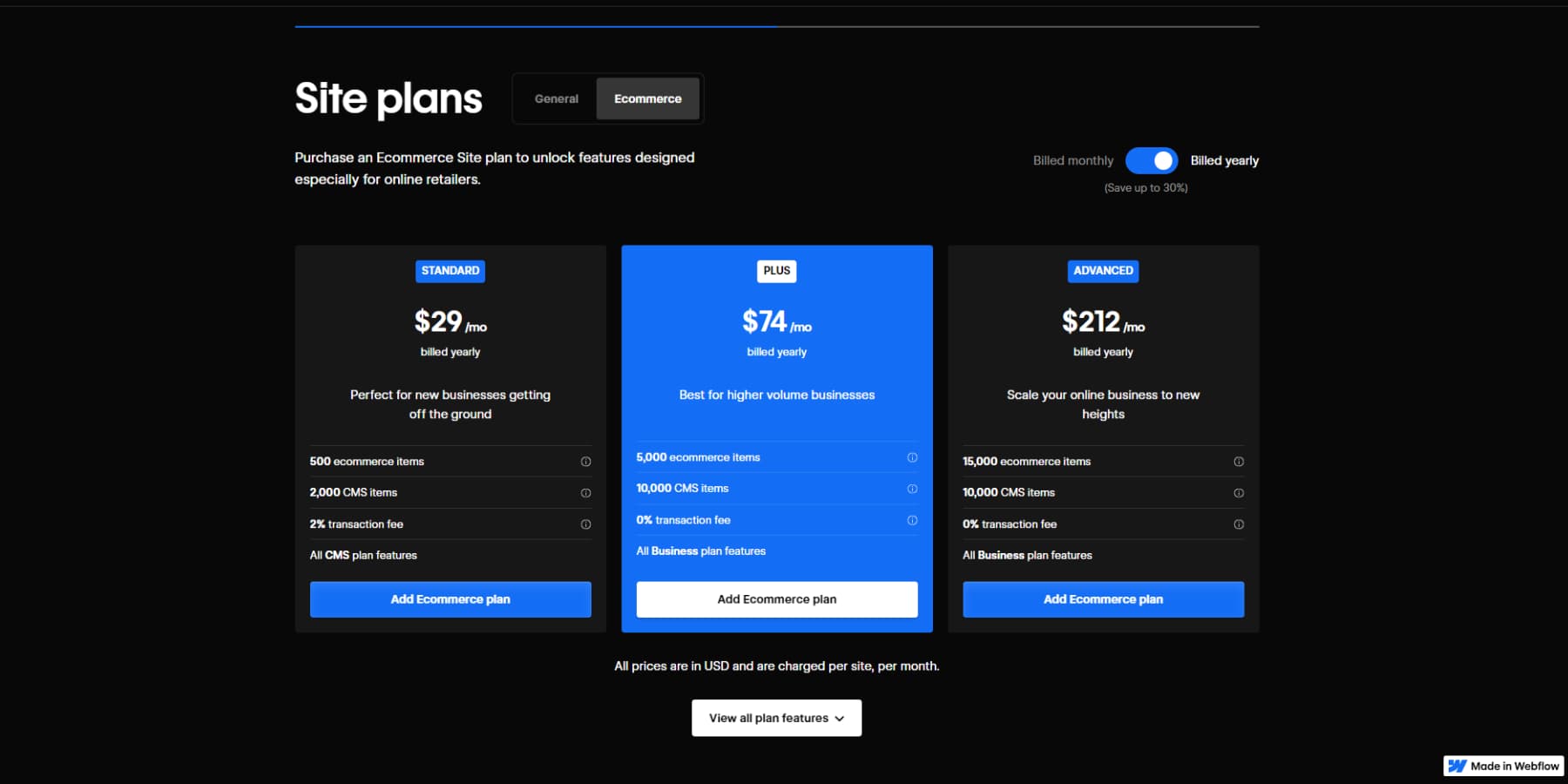
Standard
- Starts at $29/mo
- Includes all features of the CMS plan
- Allows selling up to 500 products
- It has an additional 2% transaction fee on top of the payment processor’s fees.
- But, it has branded transactional emails, i.e., all transaction emails would carry a Webflow branding
- Supports adding up to 3 staff accounts.
Plus
- Starts at $74/mo
- Includes all features of the Business plan
- The selling limit is raised to 5K products
- No additional transaction fees
- Unbranded emails
- Up to 10 staff accounts
Advanced
- Starts at $212/mo
- Includes all Business plan features
- It also includes all features of the Plus plan, plus selling up to 15K products and 15 staff accounts.
 |  |
|
|---|---|---|
| Pricing | 🥇 Winner Wix offers much more streamlined and affordable pricing, which barely has the restrictions of Webflow. | Webflow's pricing is more complex and comes with numerous limitations, even at the highest level. |
| Choose Wix | Choose Webflow |
Wix vs Webflow: Which Is Better?
Both Wix and Webflow offer website-building solutions but cater to different user needs. This section explores the pros and cons of each platform, helping you determine which best meets your specific requirements, skill level, and project goals.
Wix Is For You If…
…you want to quickly create an attractive website, particularly if you’re new to web design. Its intuitive drag-and-drop editor and premade templates allow complete beginners to assemble a quality site quickly. Even if you can’t decide which template to use, you can let Wix’s AI website builder create a website by simply answering a few questions.
With built-in solid eCommerce capabilities, it is more accessible, affordable, and better suited for eCommerce than Webflow, especially considering payment gateways, POS selling, and inventory management. Additionally, the platform offers extensive customization options through the Wix App Market and includes robust blog functionality, effectively handling most simple use cases.
Pros Of Using Wix 👍🏾
- You’ll find it incredibly simple to operate — a gentle learning curve.
- Choose from almost a thousand expertly crafted templates designed to suit your needs.
- Create custom websites using Wix ADI without relying on templates.
- You can start for free and have the option to publish your site using a Wix subdomain.
- Host of marketing tools such as email designer, CRM, and more.
- Wix provides web hosting, so your website will be hosted on their servers.
Cons Of Using Wix 👎🏾
- Storage and bandwidth limitations, especially in the starting plans.
- You can’t wholly personalize your website to achieve highly specific designs.
- It is impossible to change themes without losing content!
Webflow Is For You If…
… you’re a professional seeking more control over website hosting and management. Its exceptional design flexibility makes it stand out, allowing for extensive customization of every website element and creating unique user experiences through advanced animation features. It might not be suitable for anyone looking to launch a full-blown online store, but for basic online stores, it definitely is.
It excels in responsive design, providing significant control over the website’s appearance on various devices. Moreover, Webflow offers a substantial advantage for professional users by allowing the export and hosting of websites on third-party servers, unlike Wix. Let’s discuss its strengths and areas for improvement:
Pros Of Using Webflow 👍🏾
- You have complete control over every part of your website, from the checkout process and transactional emails to the storefront, blog designs, and beyond.
- Web hosting included
- You have access to many courses and lessons that provide thorough support. Moreover, it has a very active community to help you out.
- Access to hundreds of templates and the ability to purchase third-party templates.
- Webflow’s plans offer flexible pricing options and ample benefits, allowing you to enjoy great value, even in its starting plan.
- Better SEO tools to use
Cons Of Using Webflow👎🏾
- A steep learning curve. Even experienced designers find it hard to master completely.
- Limited eCommerce features
- There are limitations on all aspects of a website, such as pages, form submissions, blog posts, custom posts, etc.
- While some templates are free, most are paid, which can be an added cost over the subscription.
 |  |
|
|---|---|---|
| Features | 🏳️ Draw Wix's features are more geared towards beginners, including AI tools and templates. | 🏳️ Draw While Webflow doesn't have many features that Wix provides, it still offers unprecedented flexibility in terms of design. A brownie point would also go for the availability of third-party templates. |
| Ease of Use | 🥇 Winner Wix's user interface, hands down, is much easier to use. However, this ease of use sometimes means compromising on some flexibility. This might not be an issue for beginners or intermediate users. | Webflow's user interface and learning curve are steep, so much so that even experienced users sometimes find it hard to use. However, with this complexity comes total control over all design aspects of the website. |
| SEO and Marketing | 🥇 Winner Wix makes marketing easier for you by letting you update what appears in Google searches through its easy-to-use SEO wizard and integrations, and also by enabling customized emails. Its blogging features while limited is still very simple to use. | Webflow, while providing the same SEO features, lacks an automatic wizard and integrations, which may require manual work. The email features are limited to just transactional emails. The Webflow CMS is very flexible but complex and unintuitive with severe limitations. |
| Pricing | 🥇 Winner Wix offers much more streamlined and affordable pricing, which barely has the restrictions of Webflow. | Webflow's pricing is more complex and comes with numerous limitations, even at the highest level. |
| Choose Wix | Choose Webflow |
Wix and Webflow are excellent choices for website building, but they cater to different needs. If you prefer a simple design process, Wix should be your go-to. However, if complete control over the design is more important to you, Webflow is the ideal option. If you’re unsure about which to choose, why not explore both? Both platforms offer free versions. Sign up using your email to experiment with their features without commitment.
Still torn between Wix vs Webflow? Don’t fret. They’re not your sole options. We’ve got an excellent roundup of the best website builders for you to peruse. Have you ever pondered the benefits of merging the simplicity, flexibility, AI features, and templates of Wix with the fine-grained control and advanced functionality of Webflow? Well, your answer is the Divi theme! Discover more here.

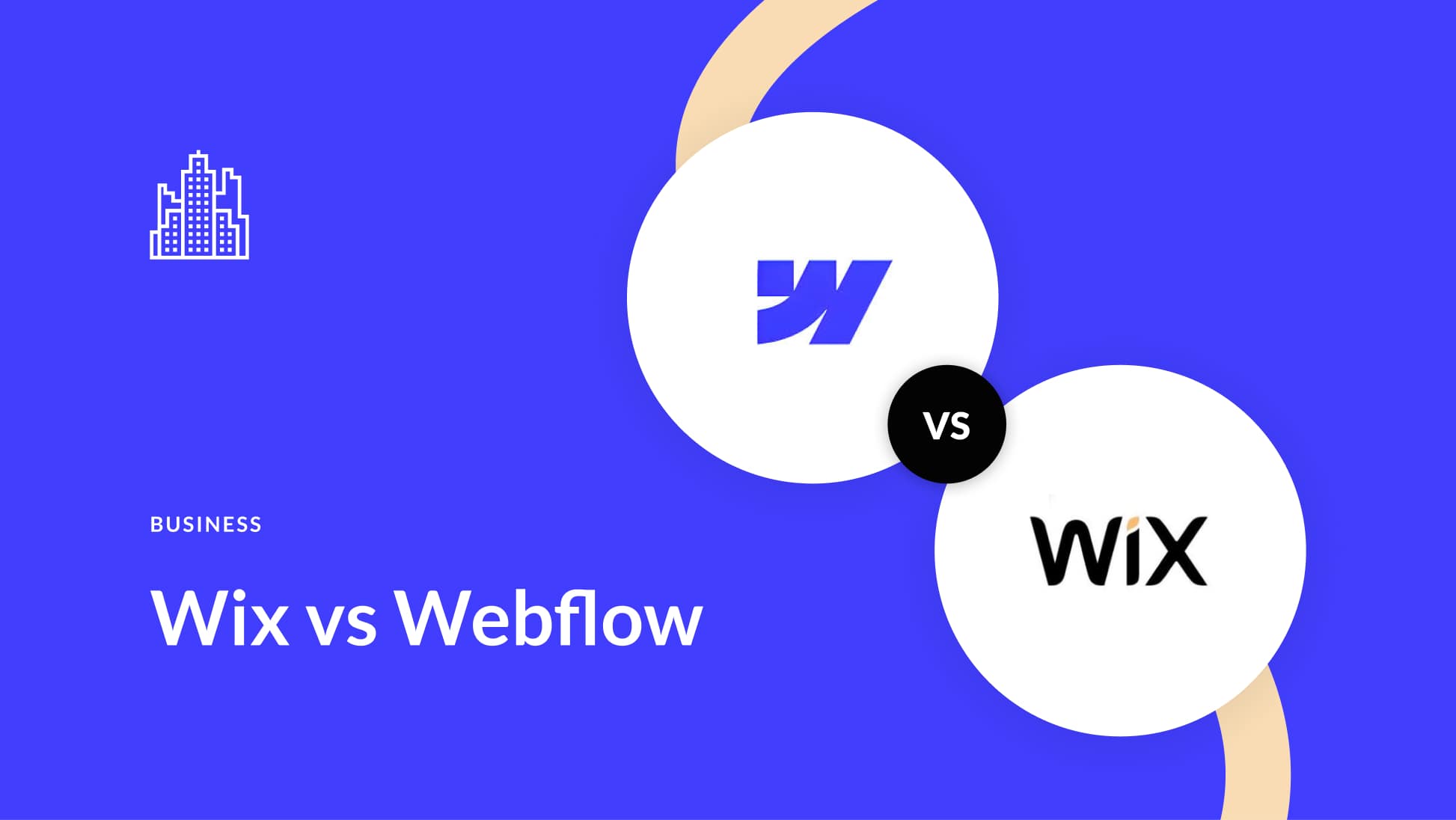
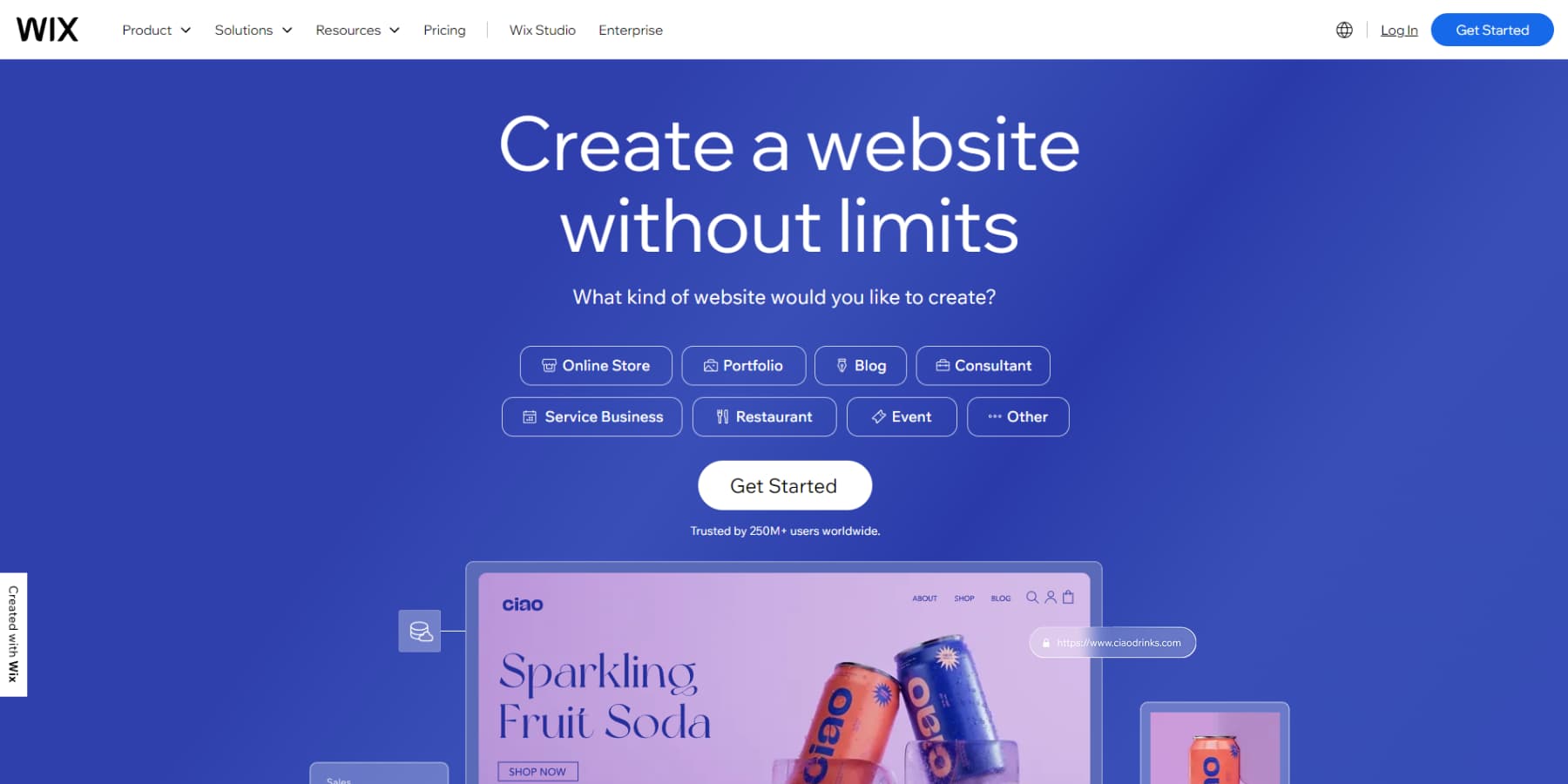





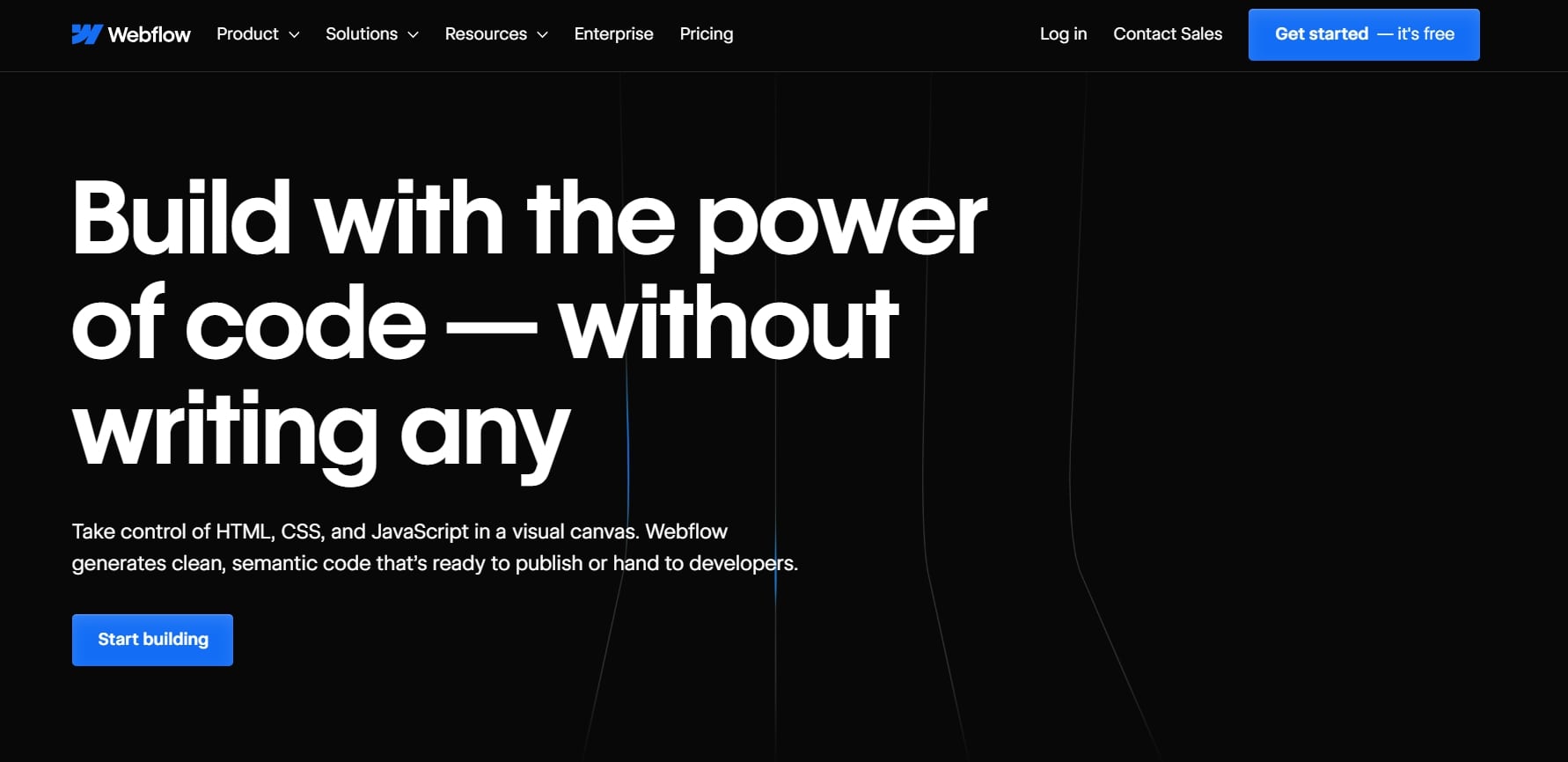




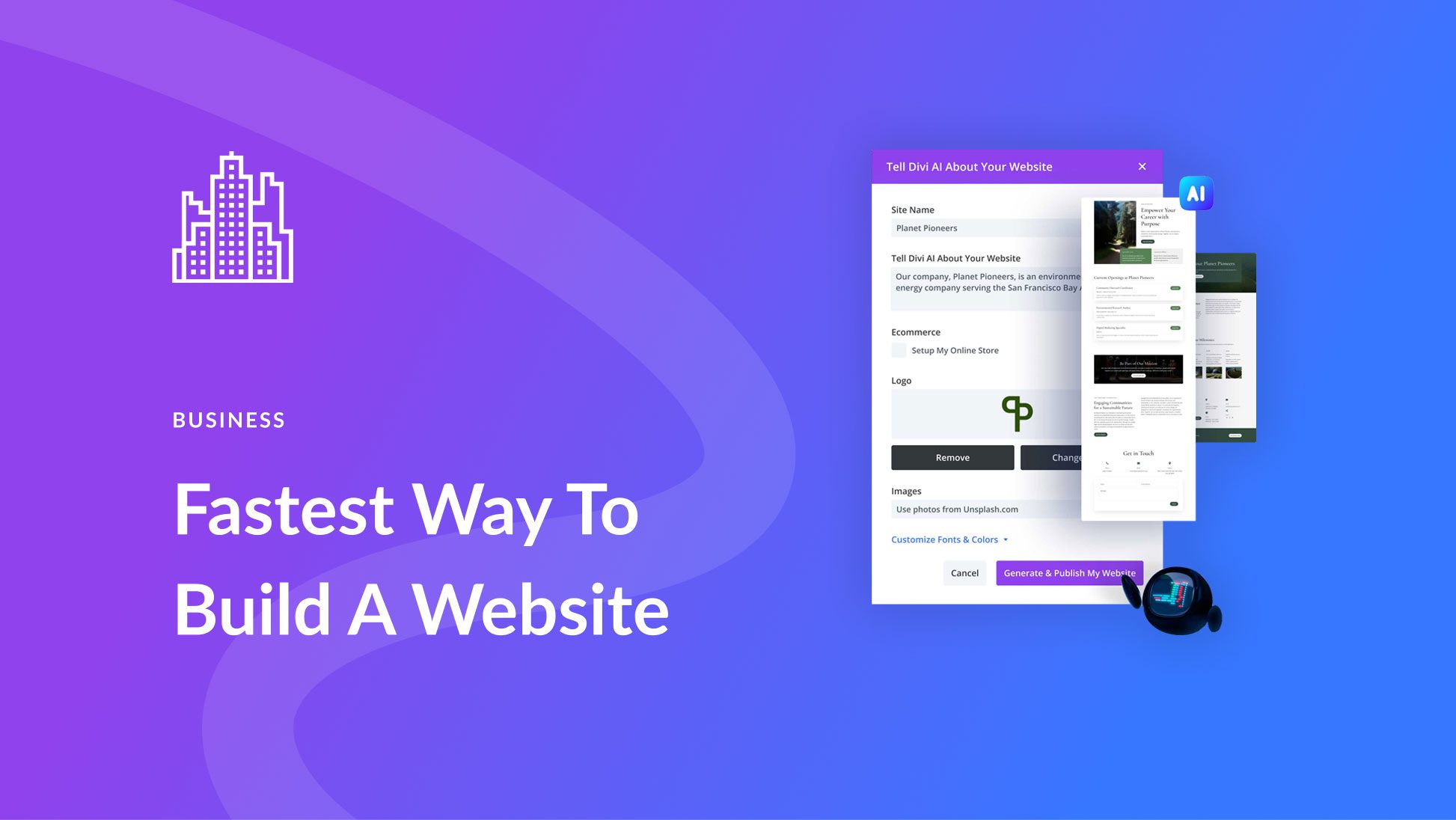
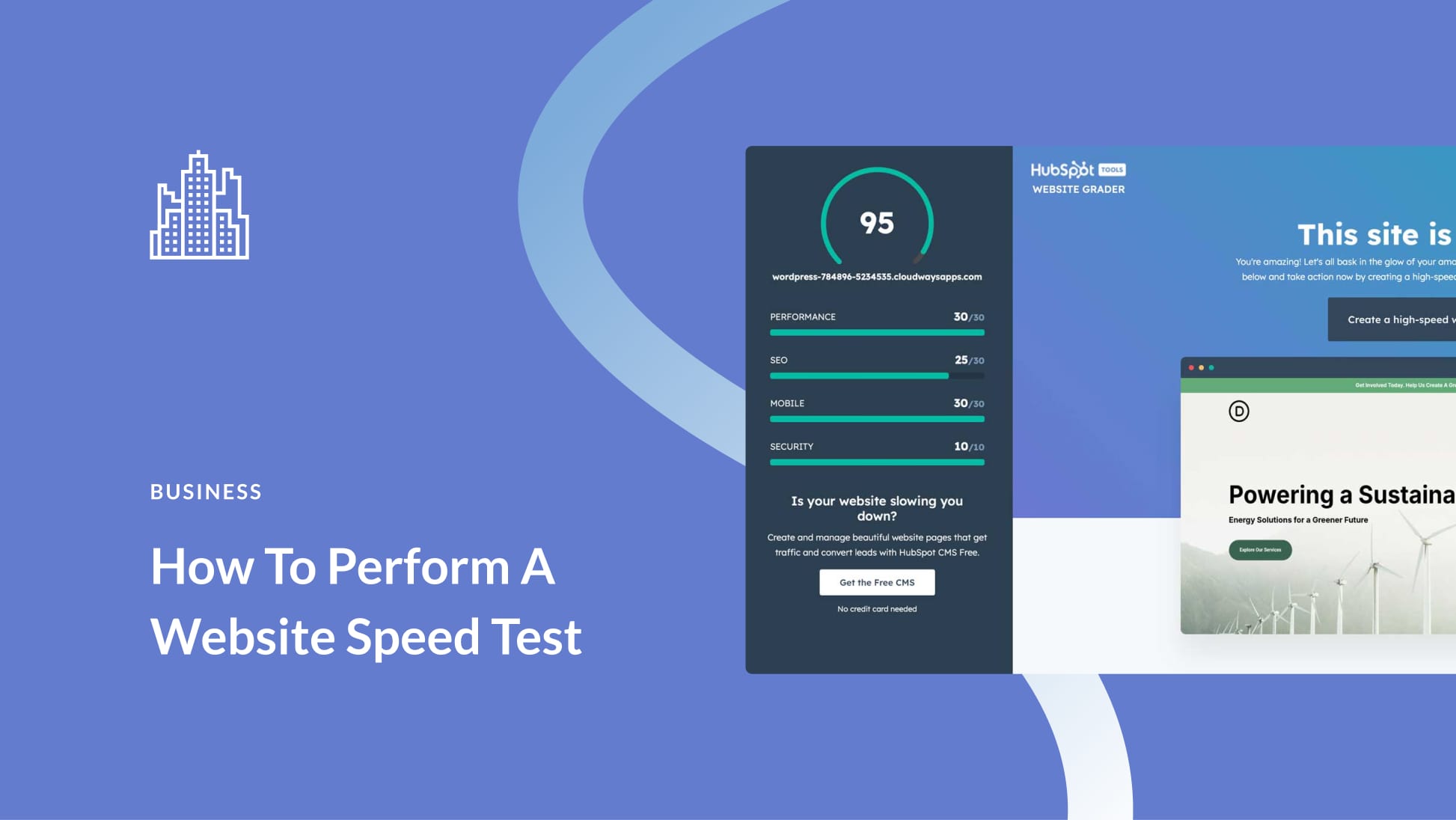
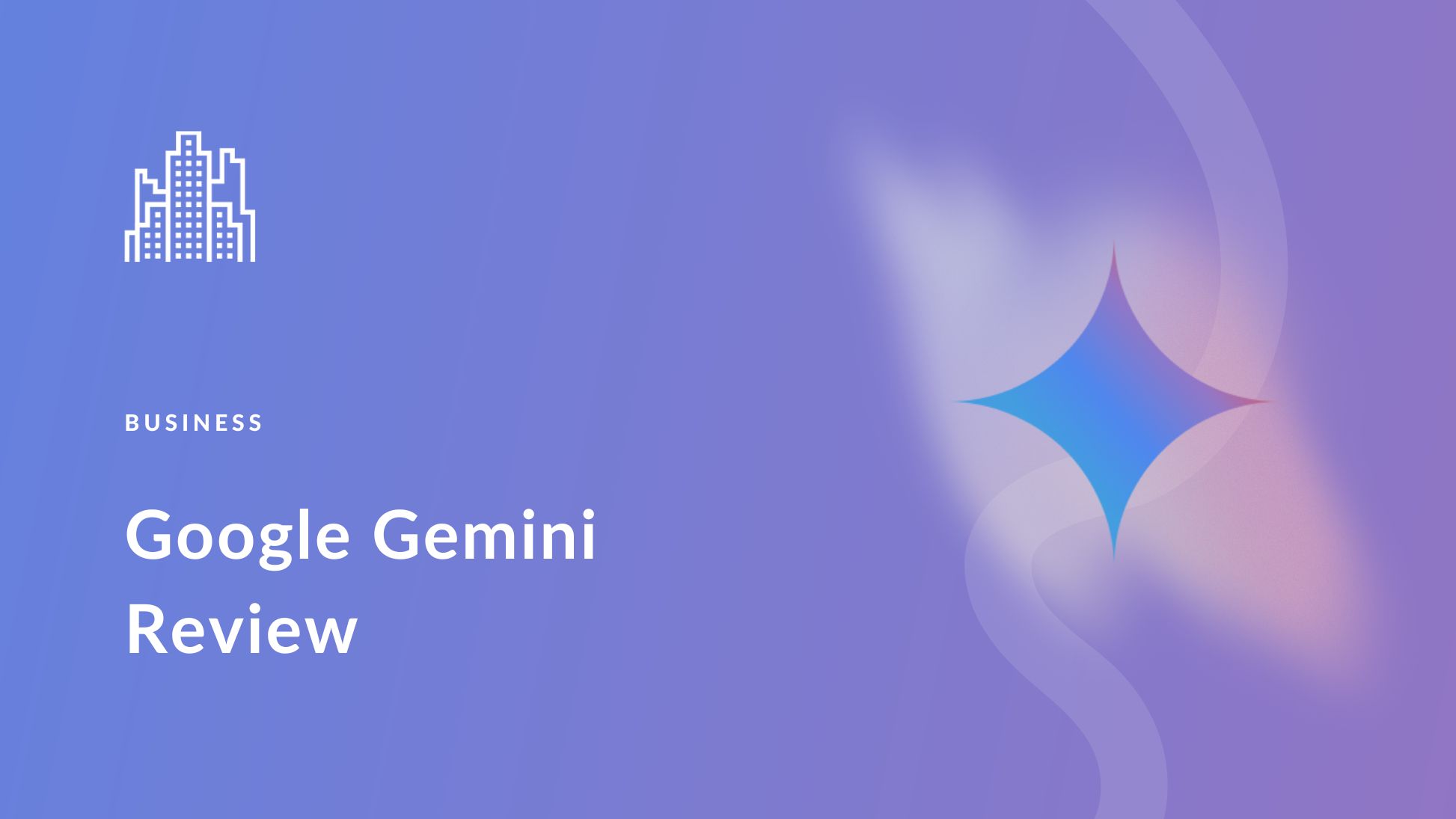
Leave A Reply